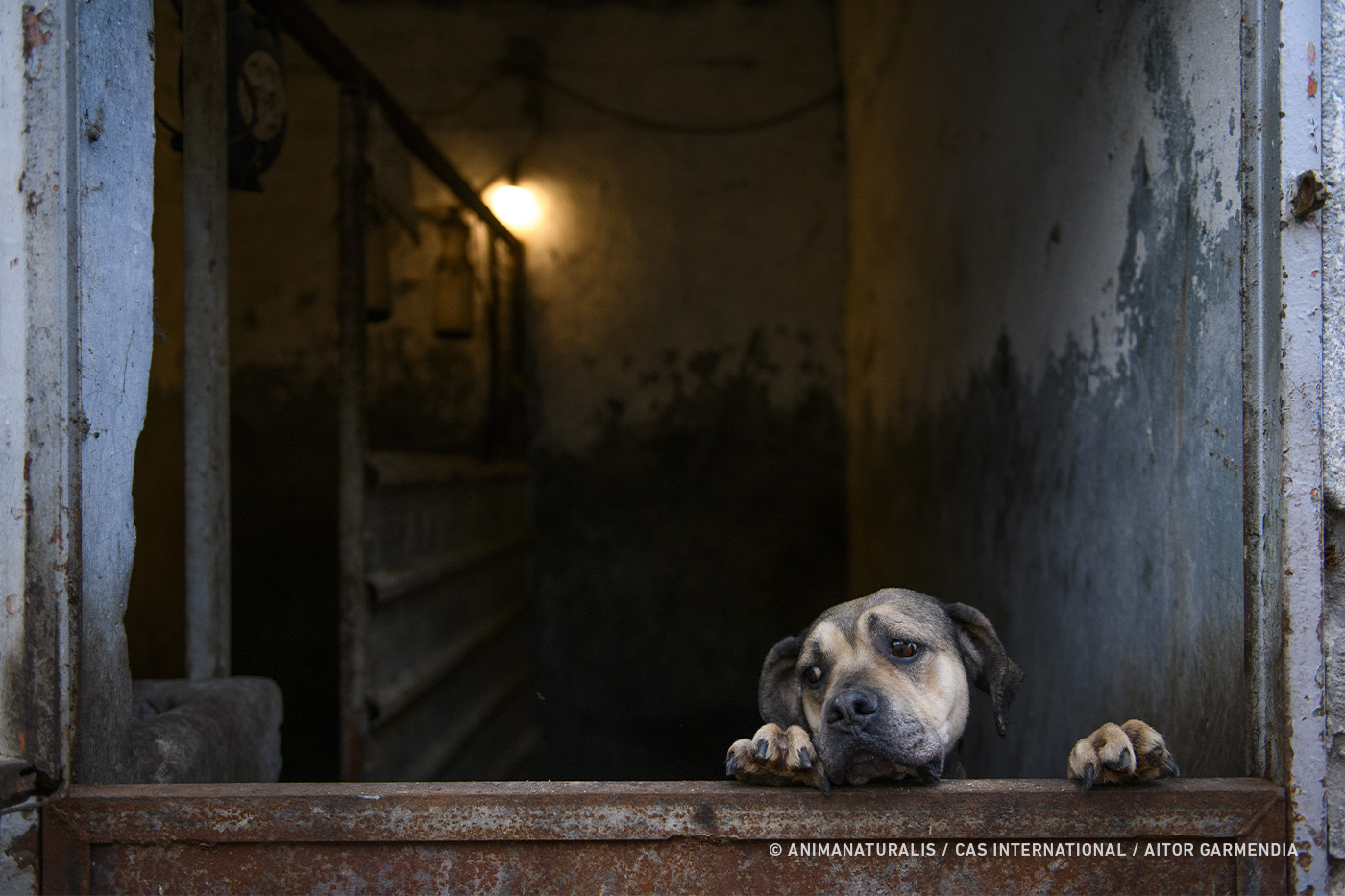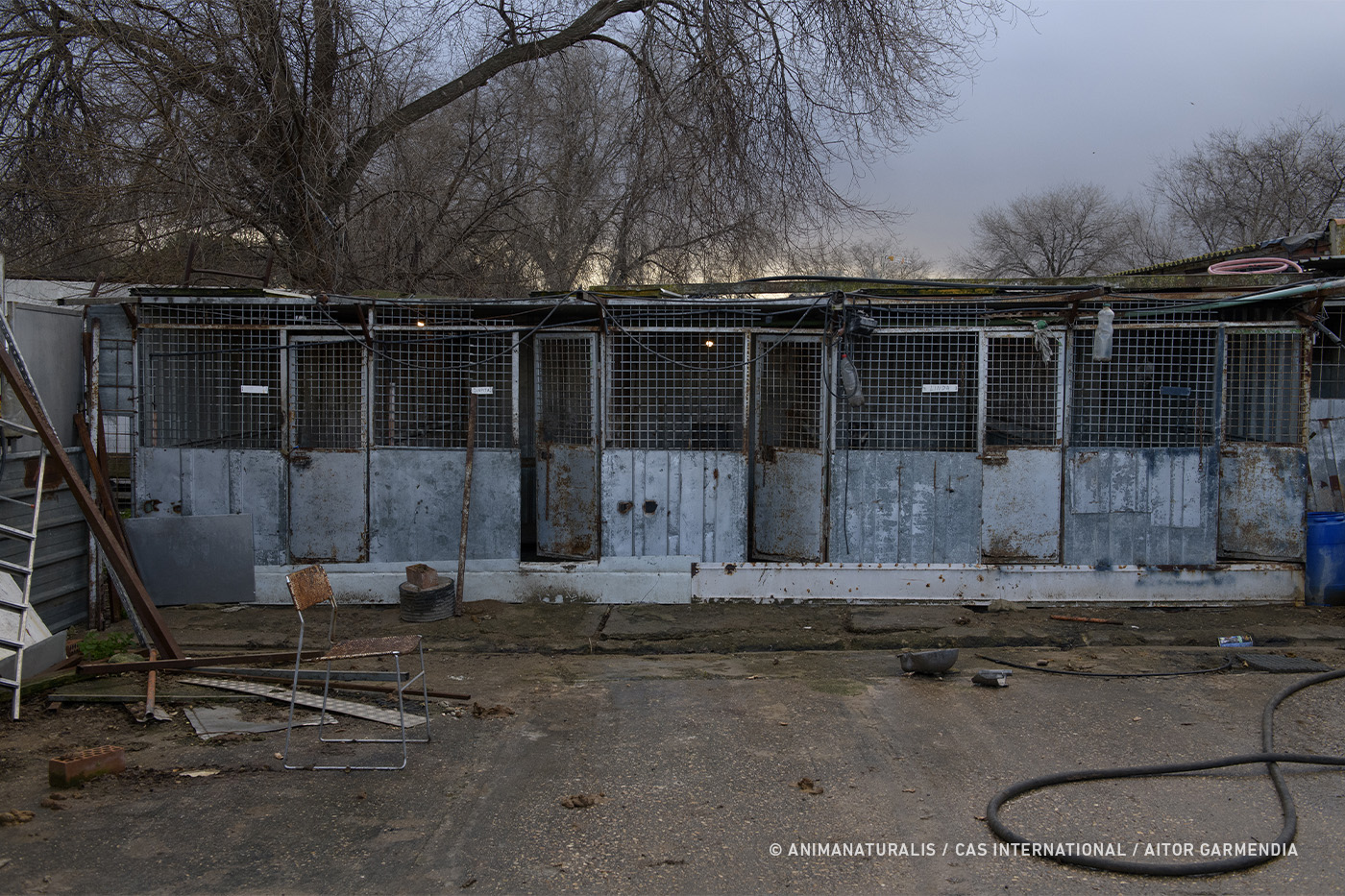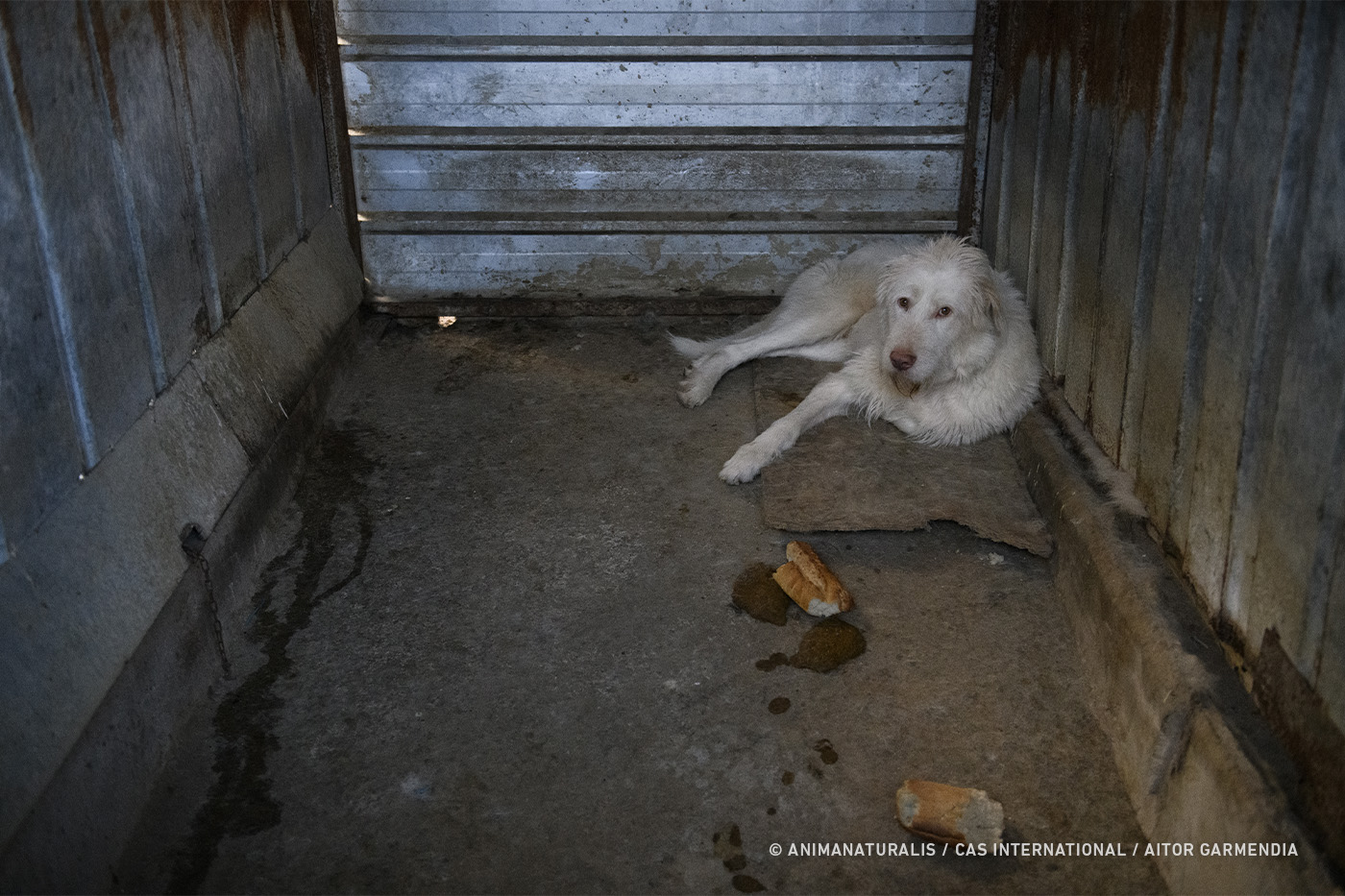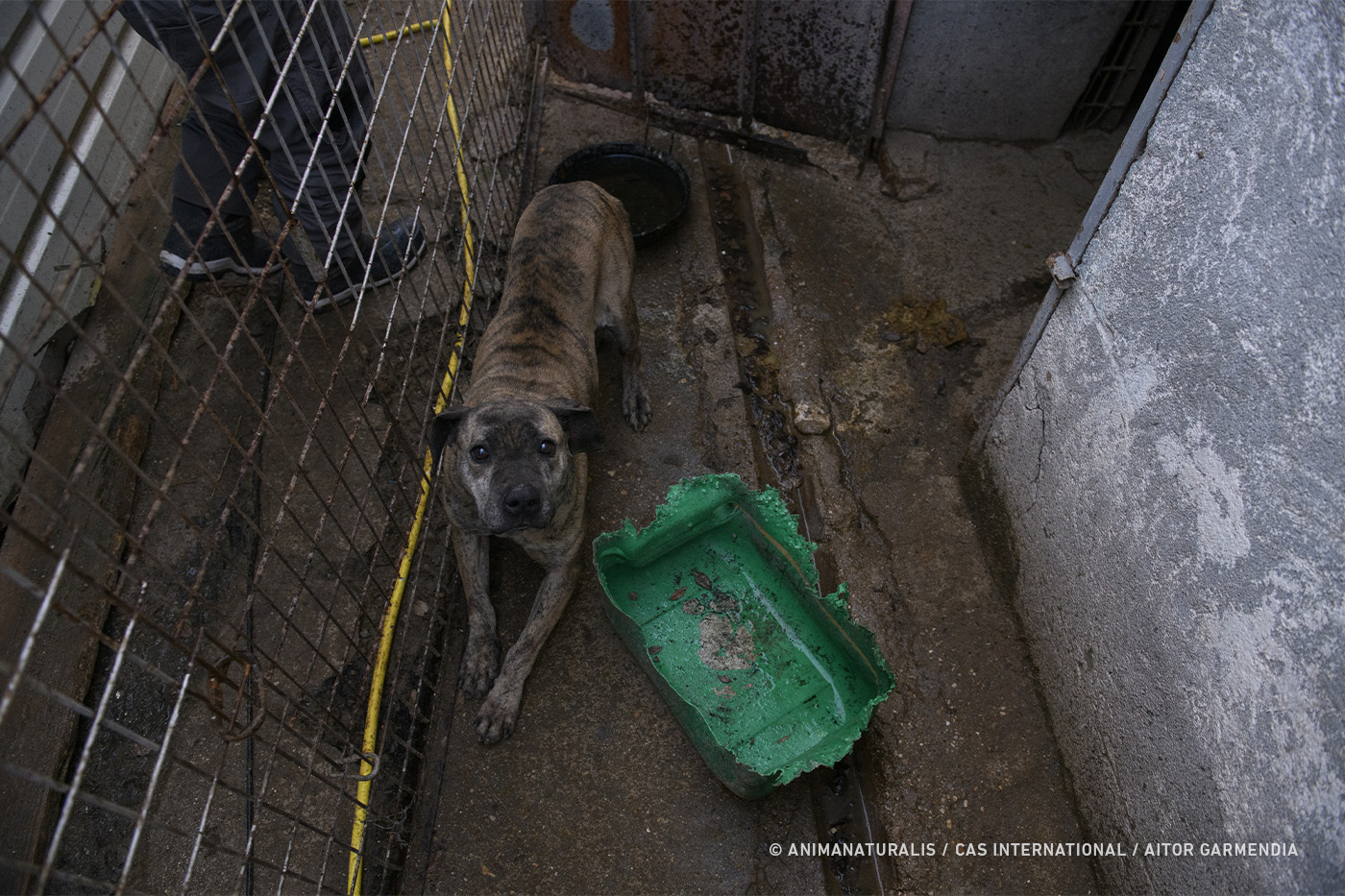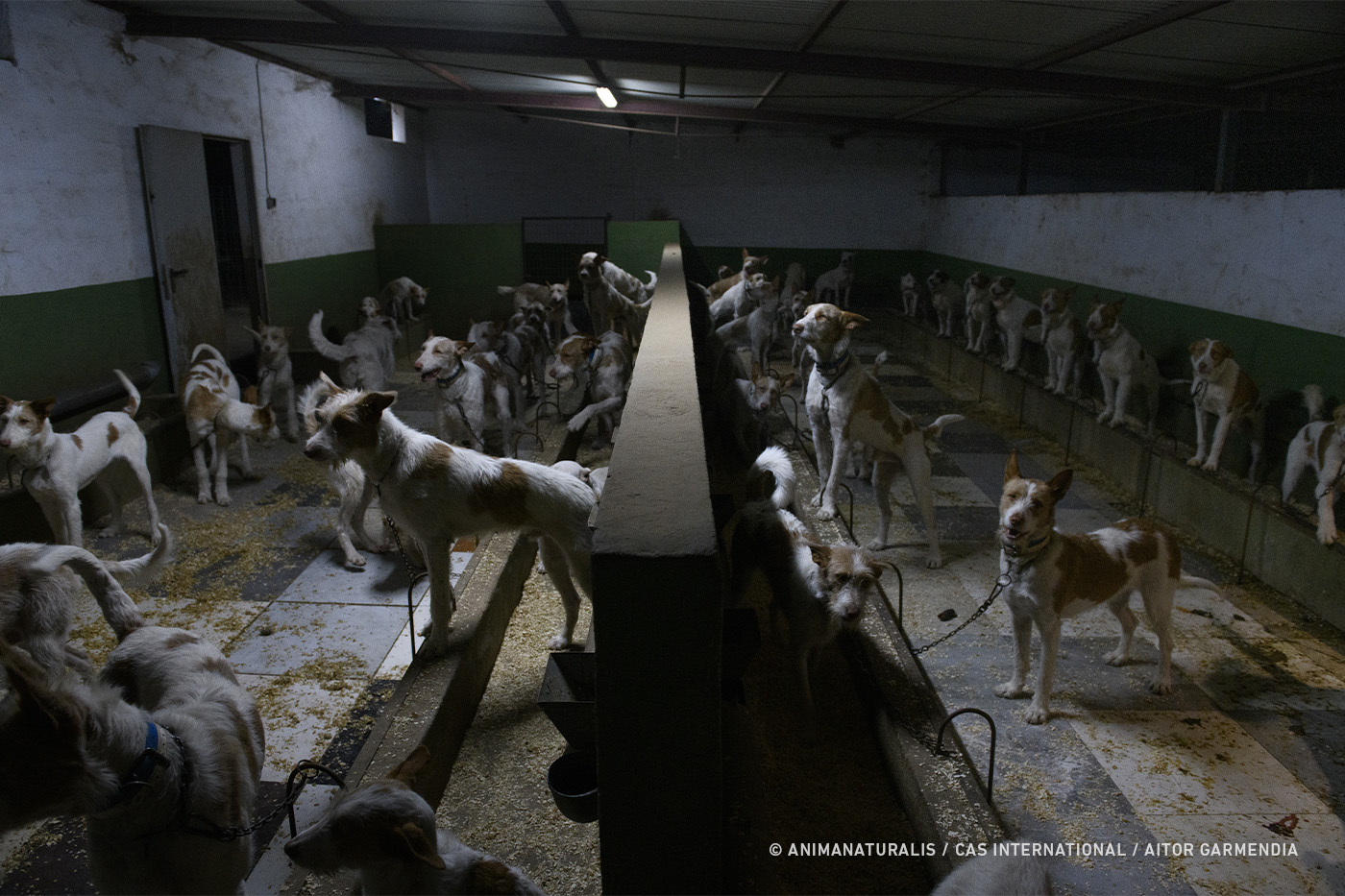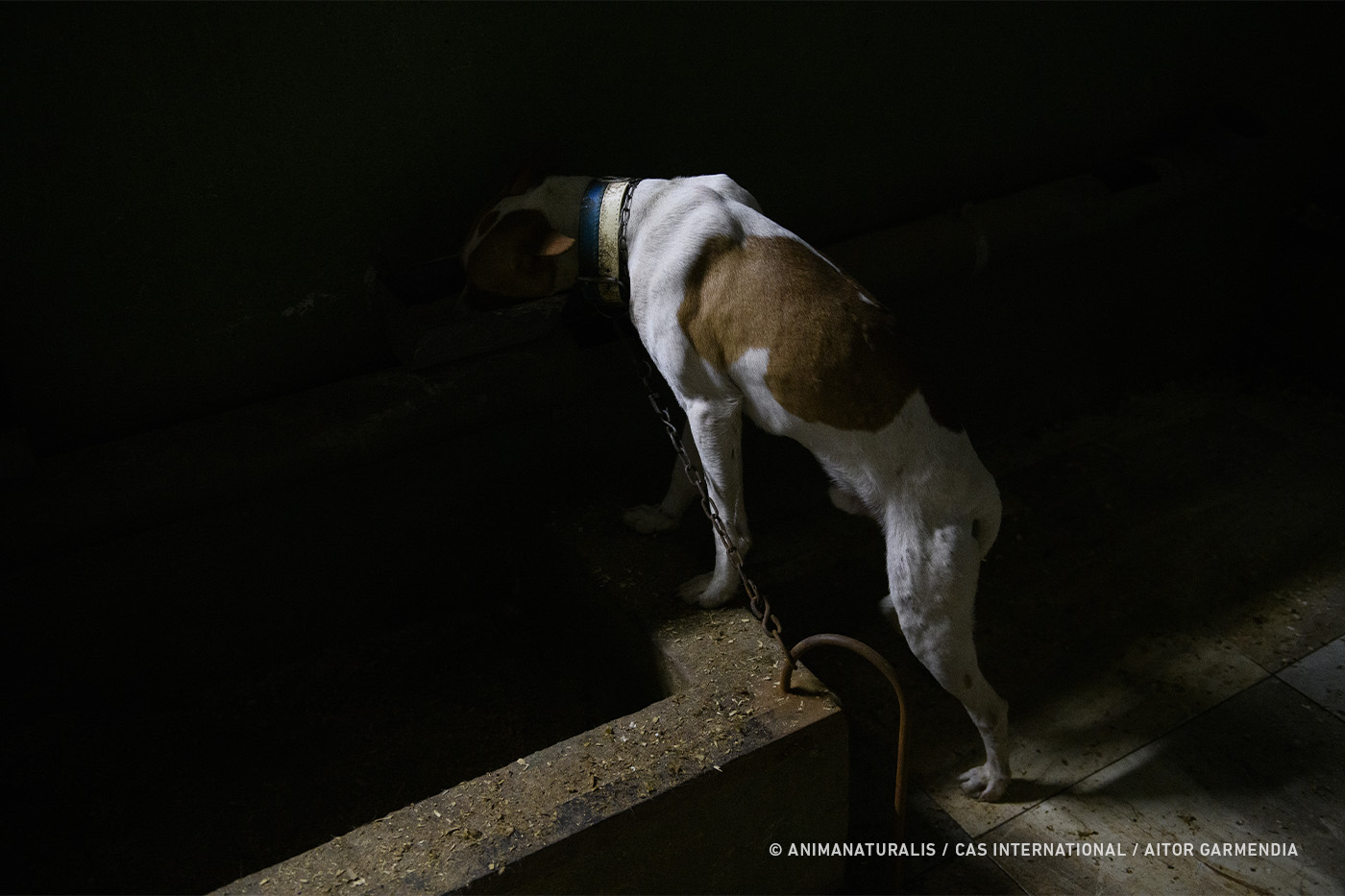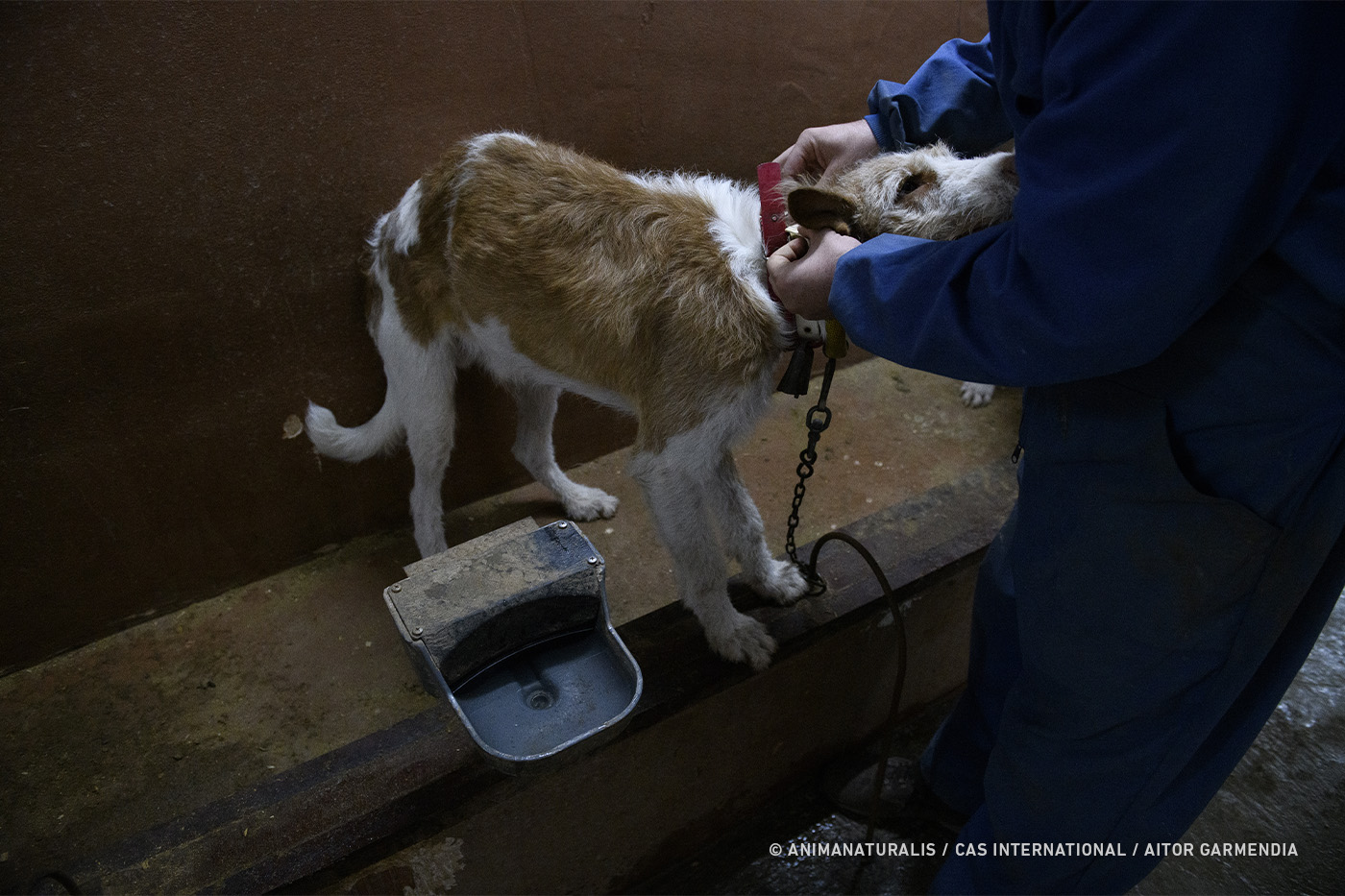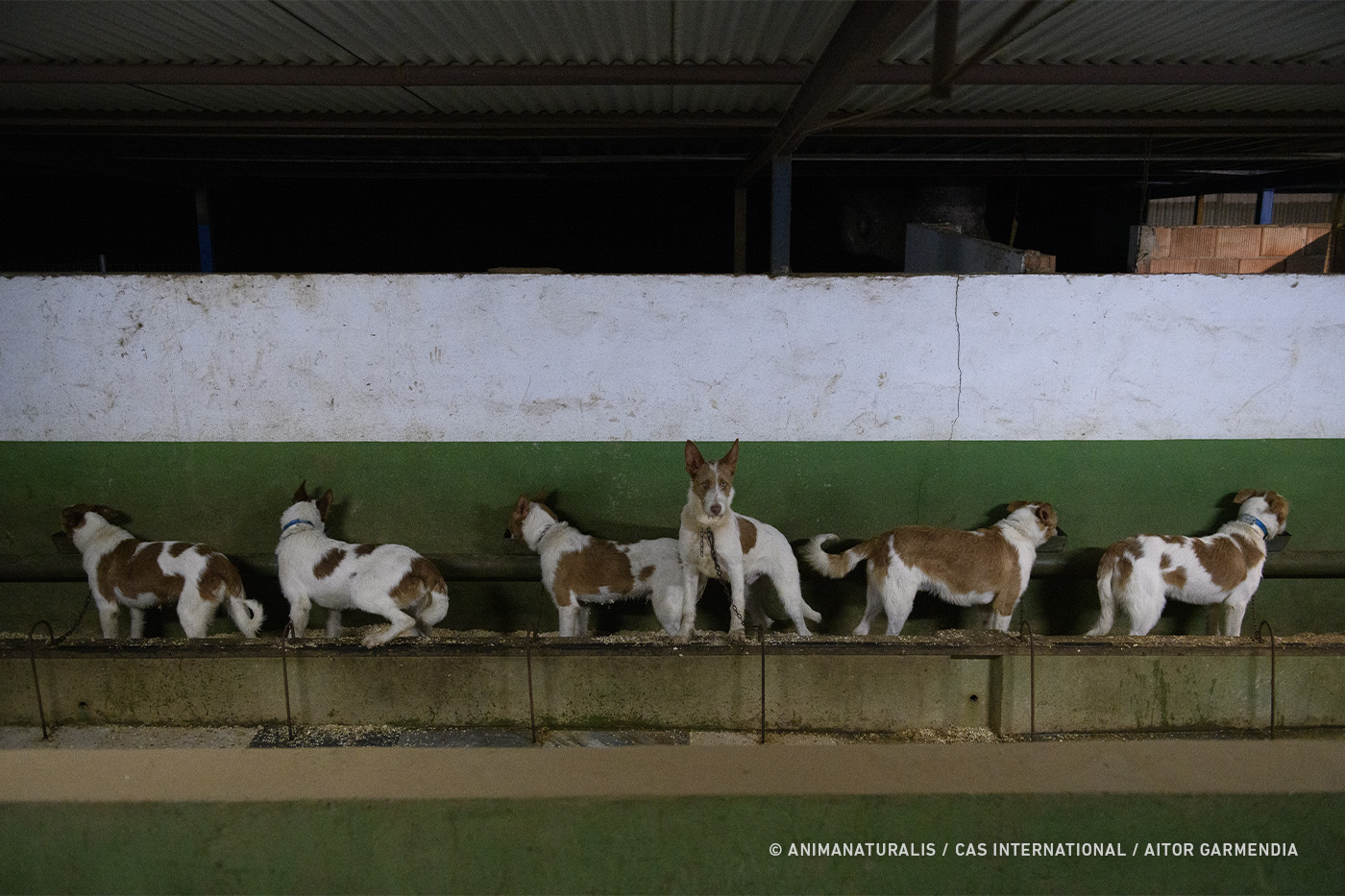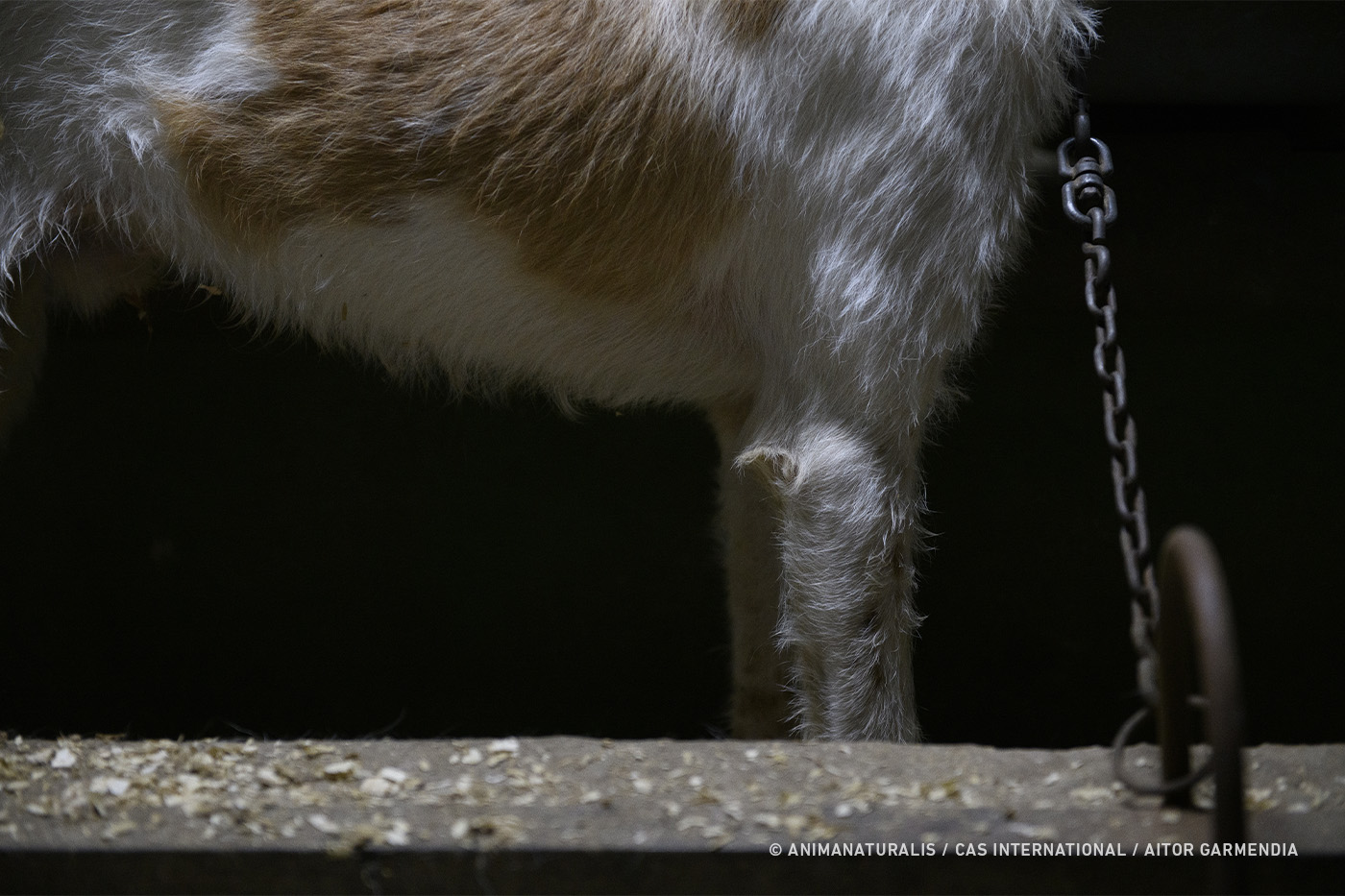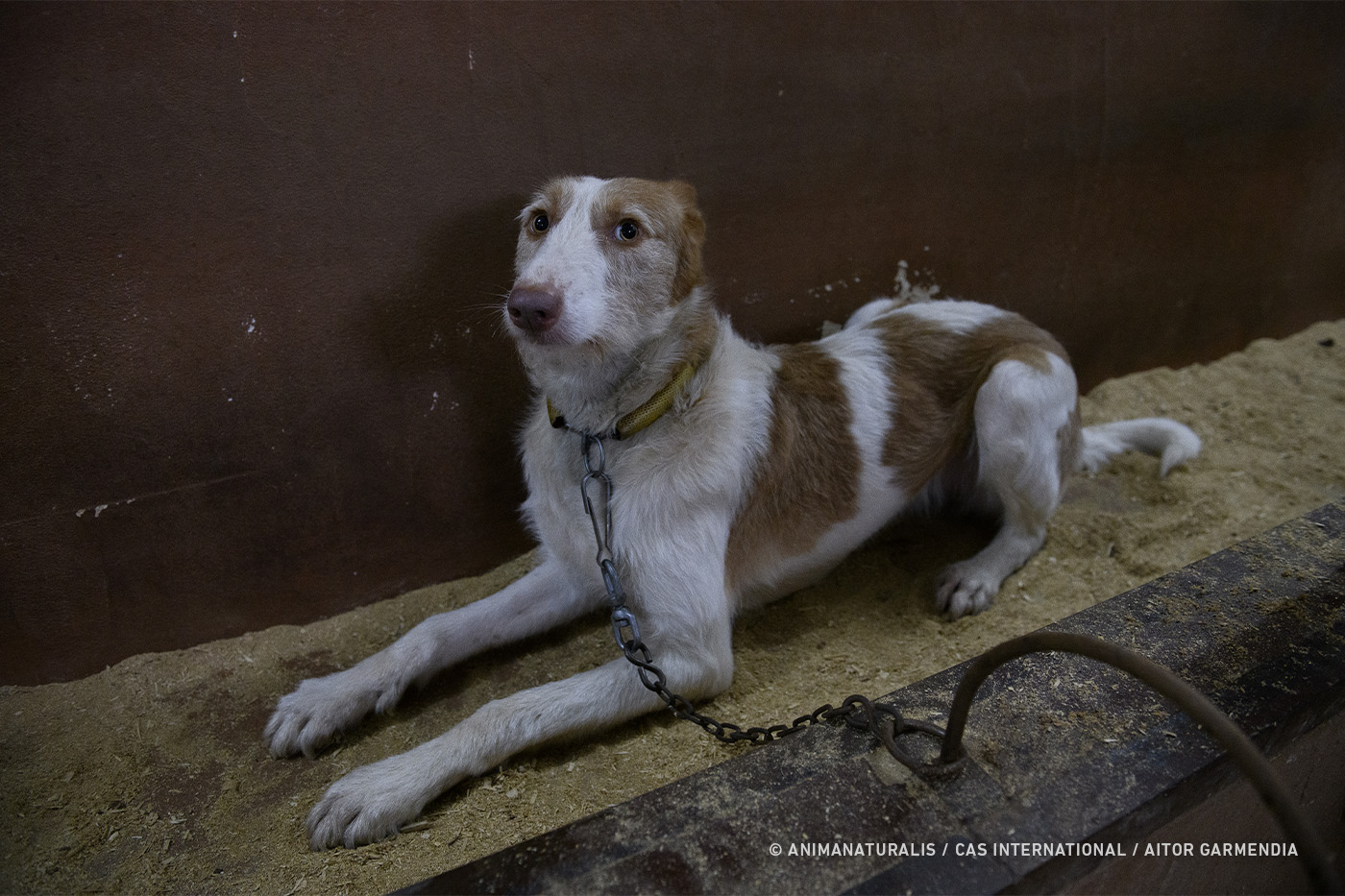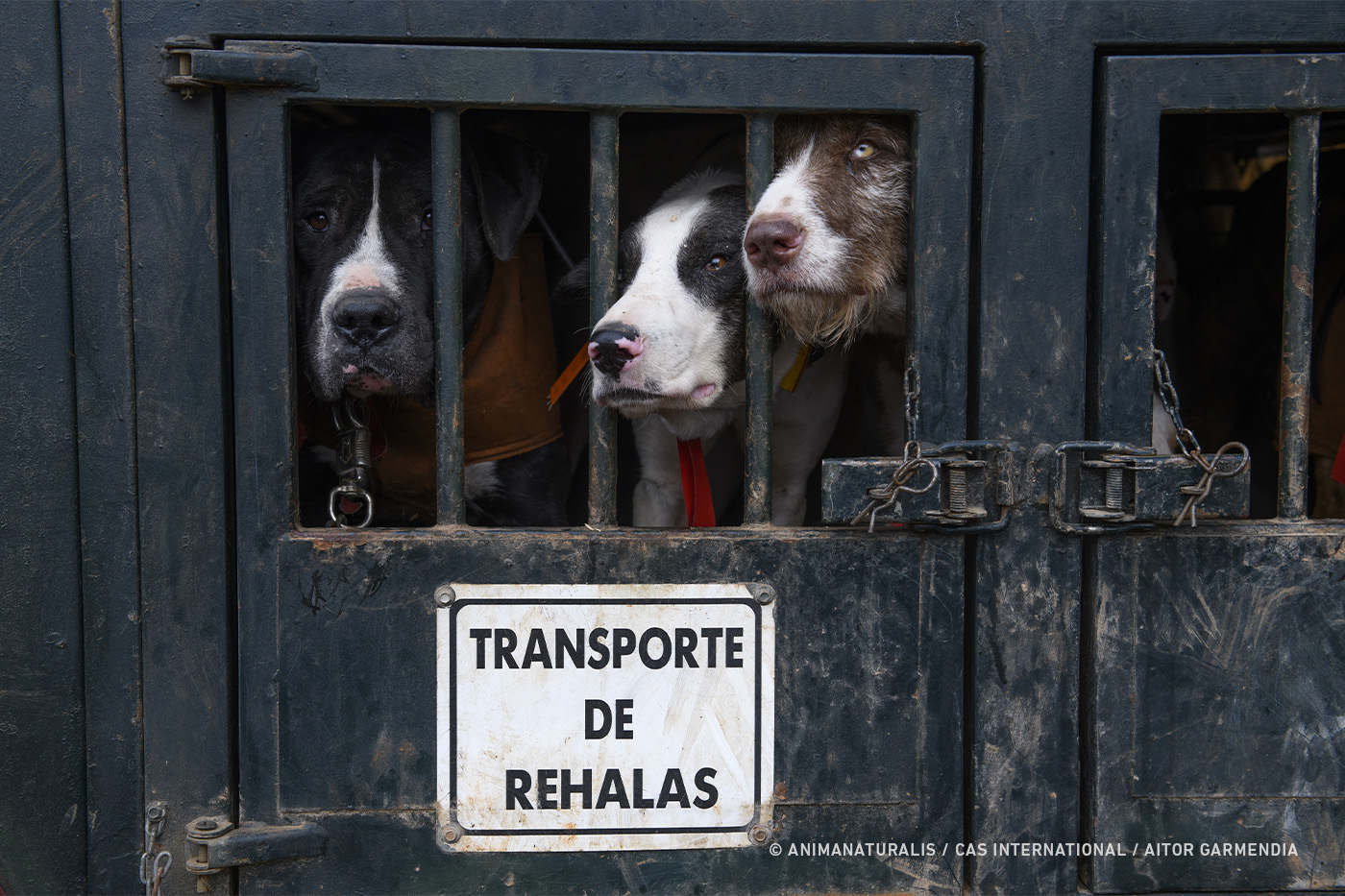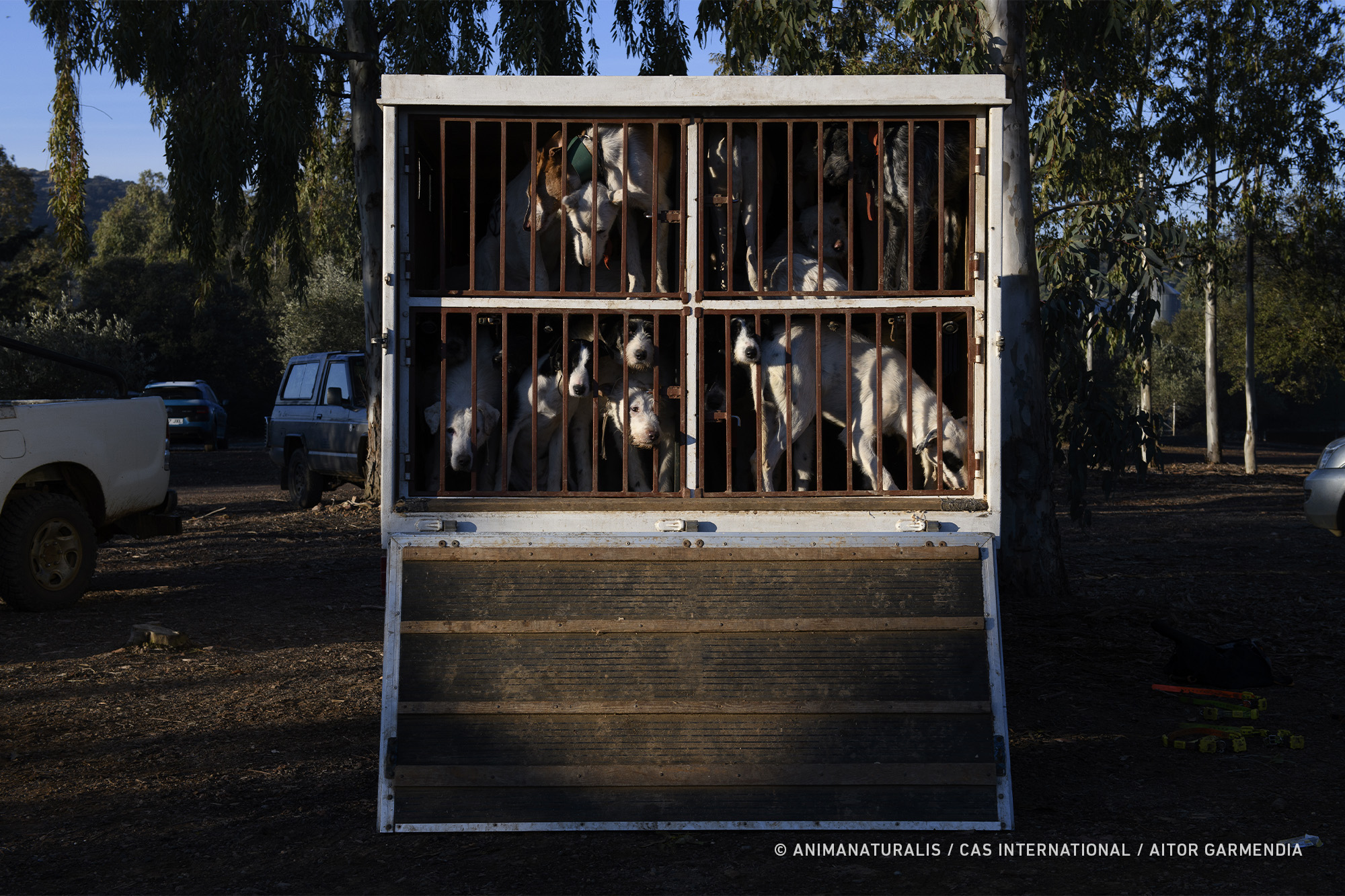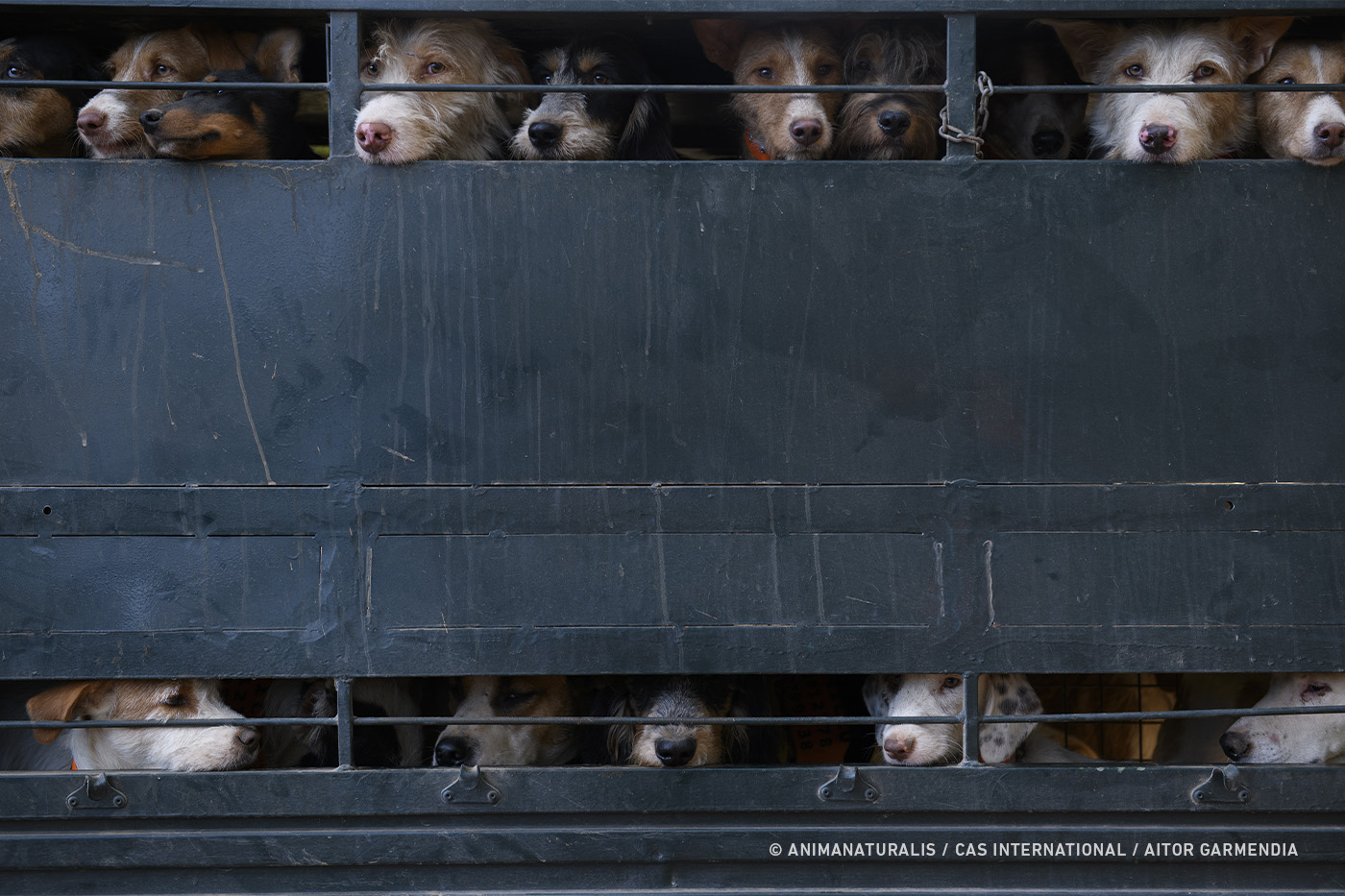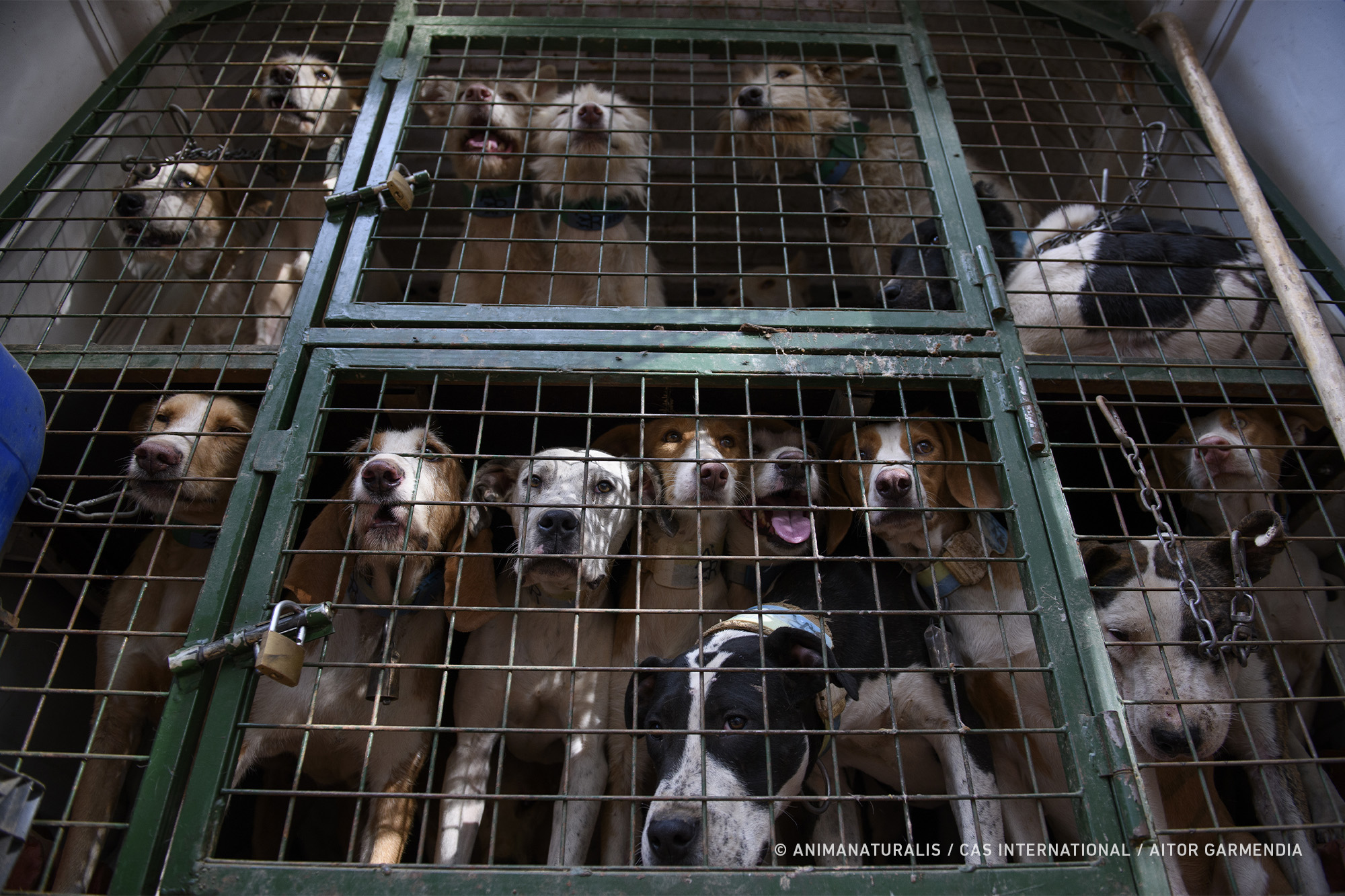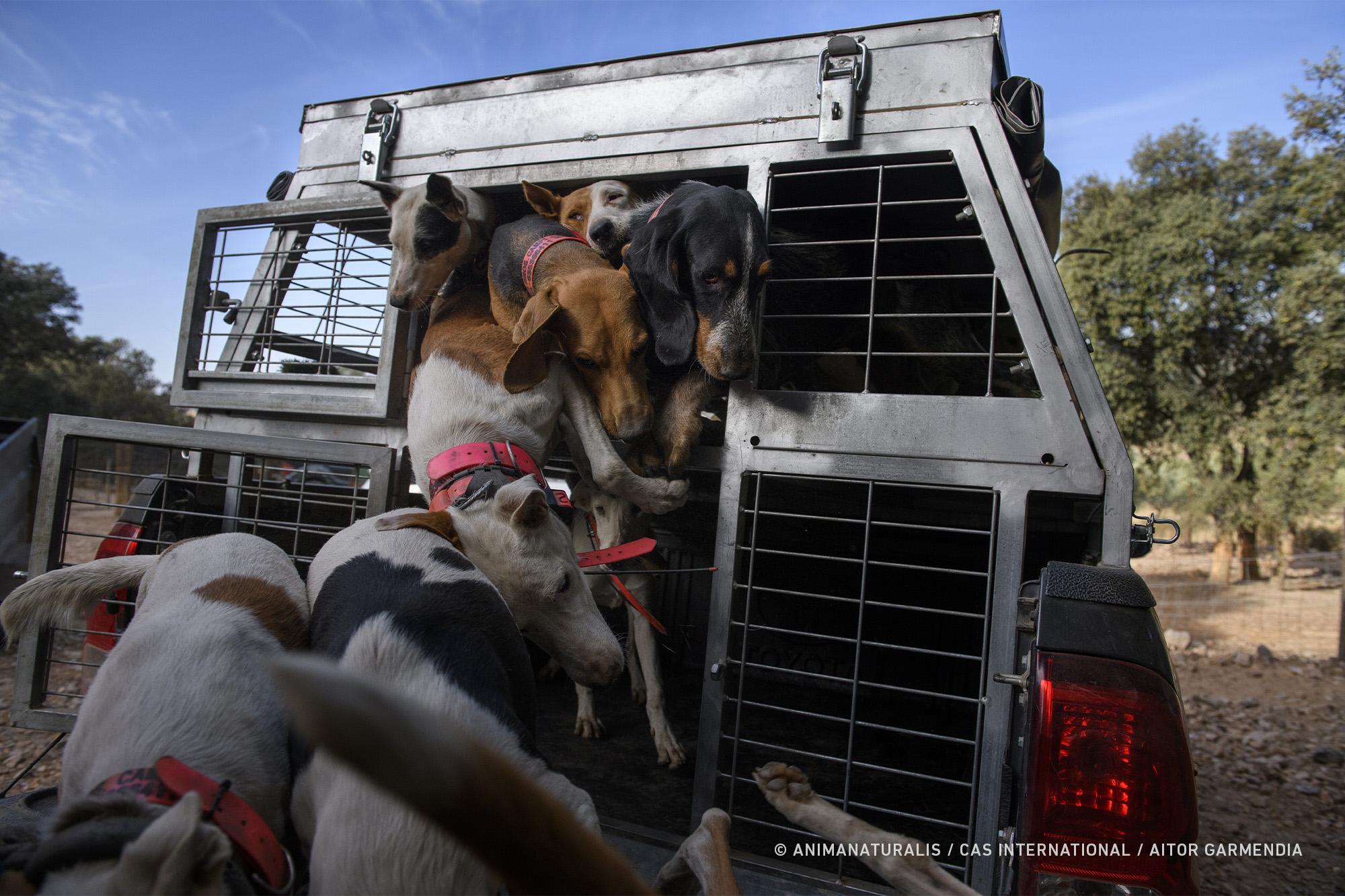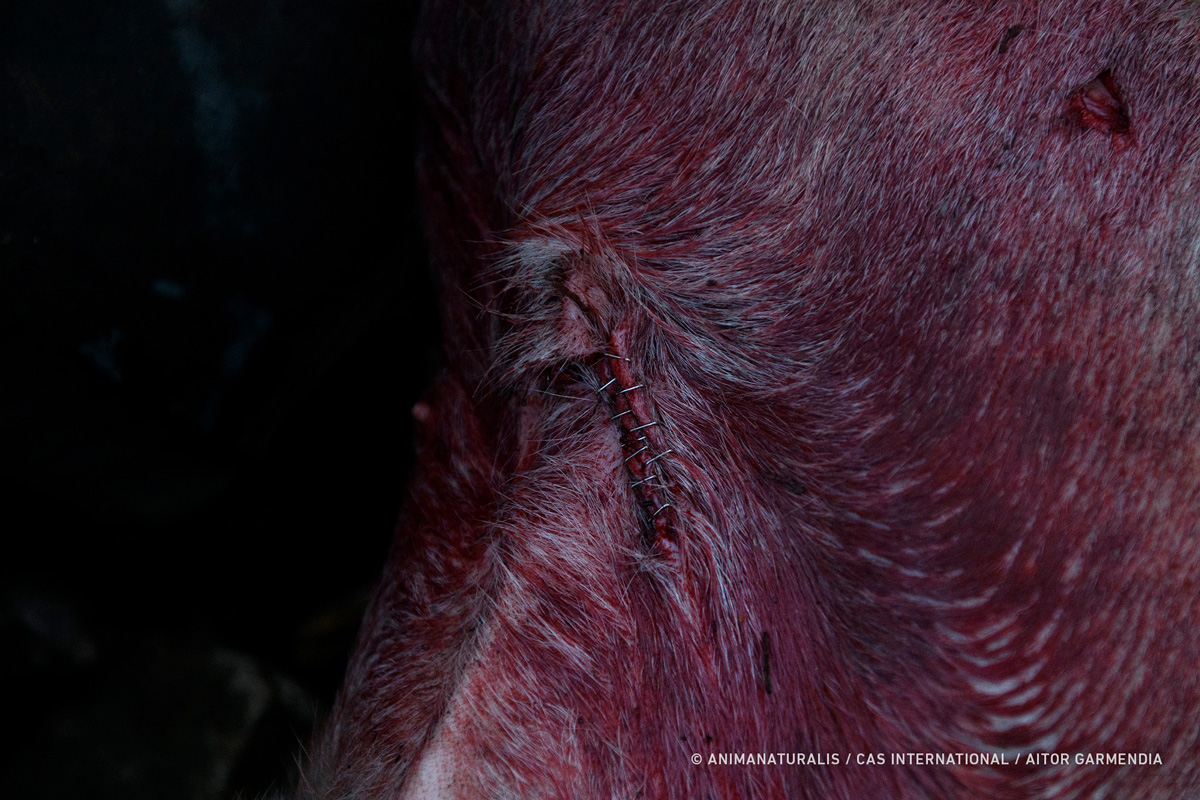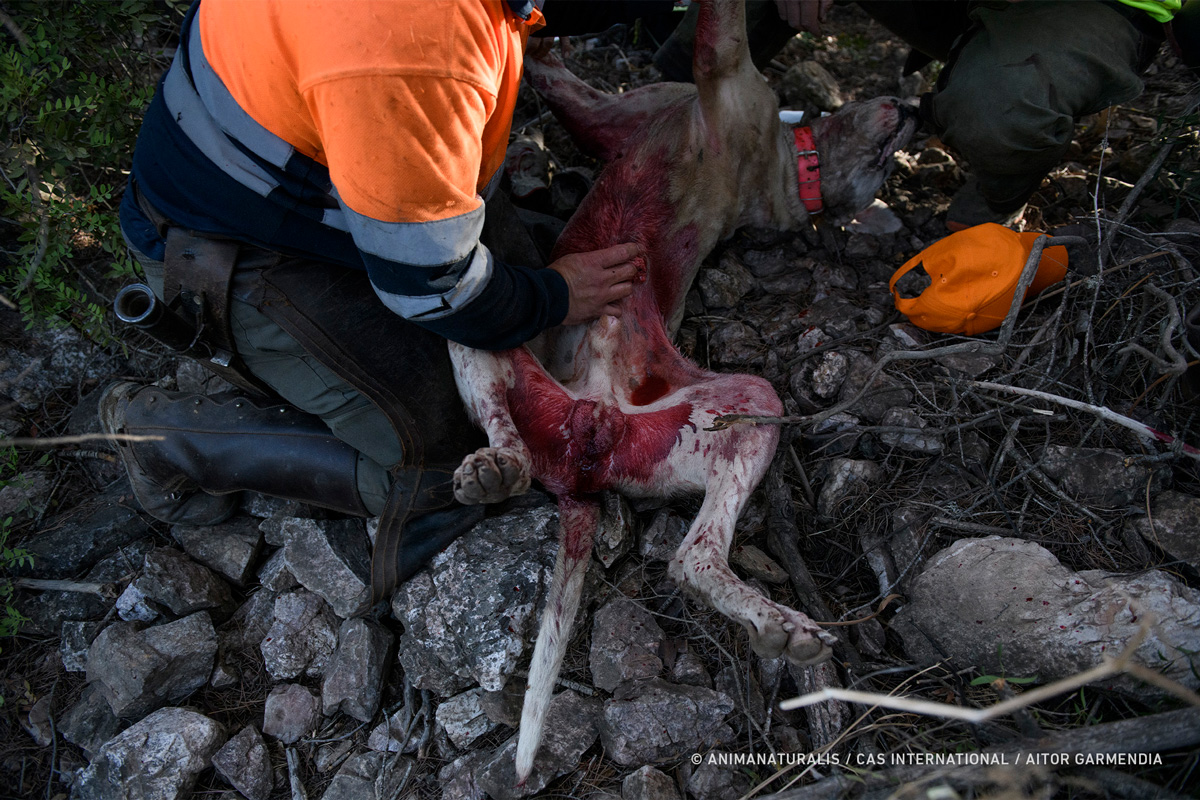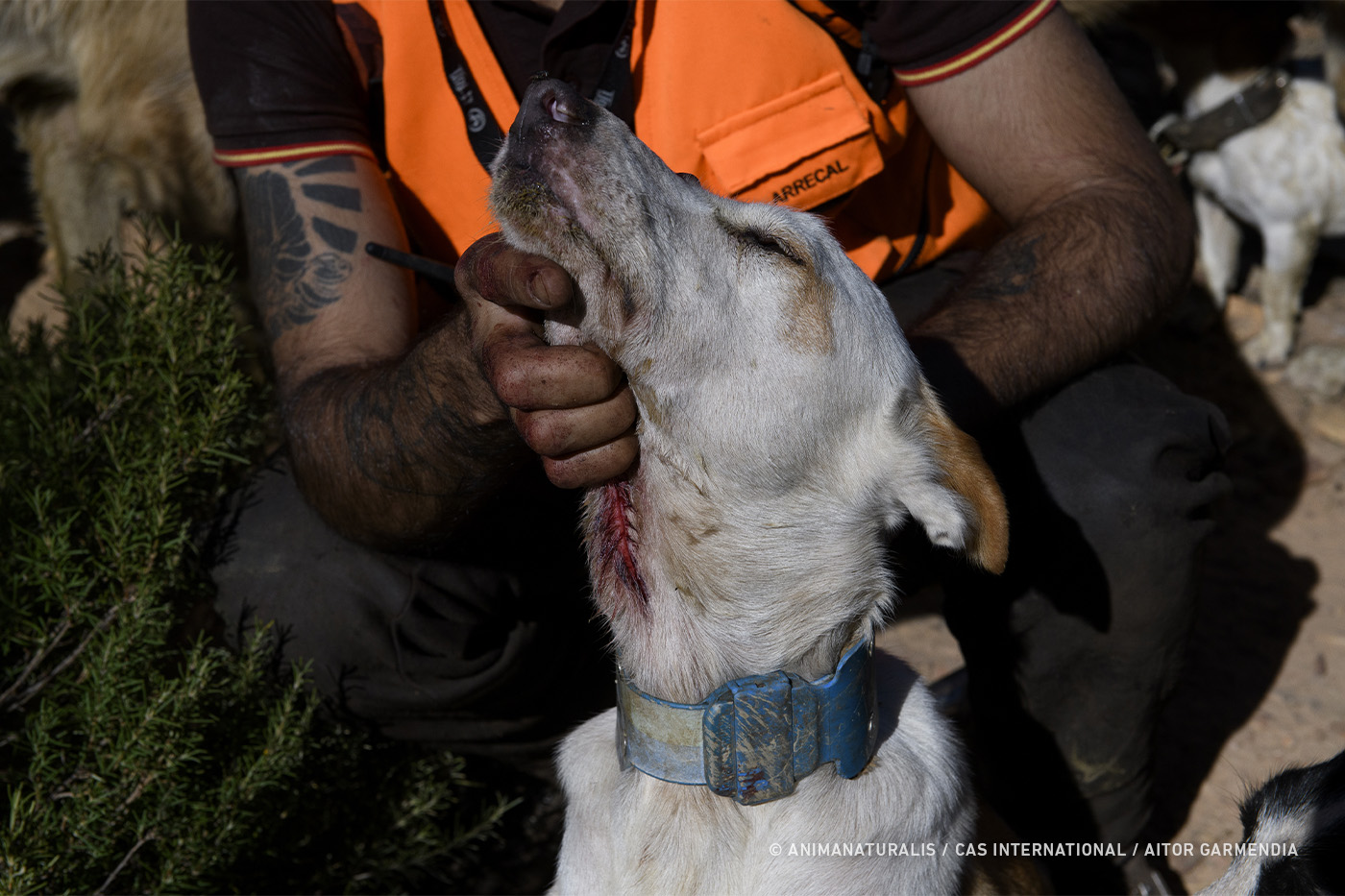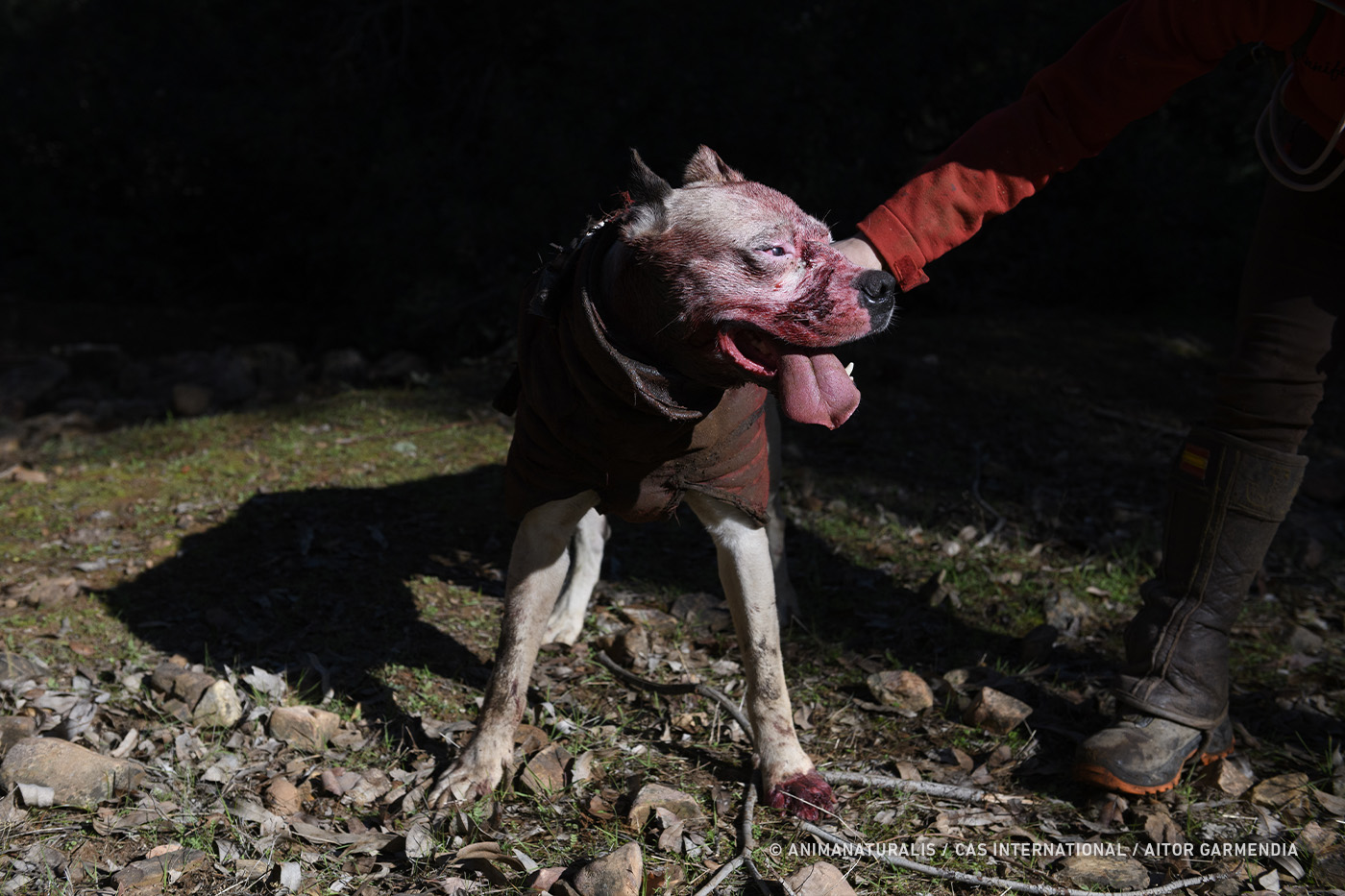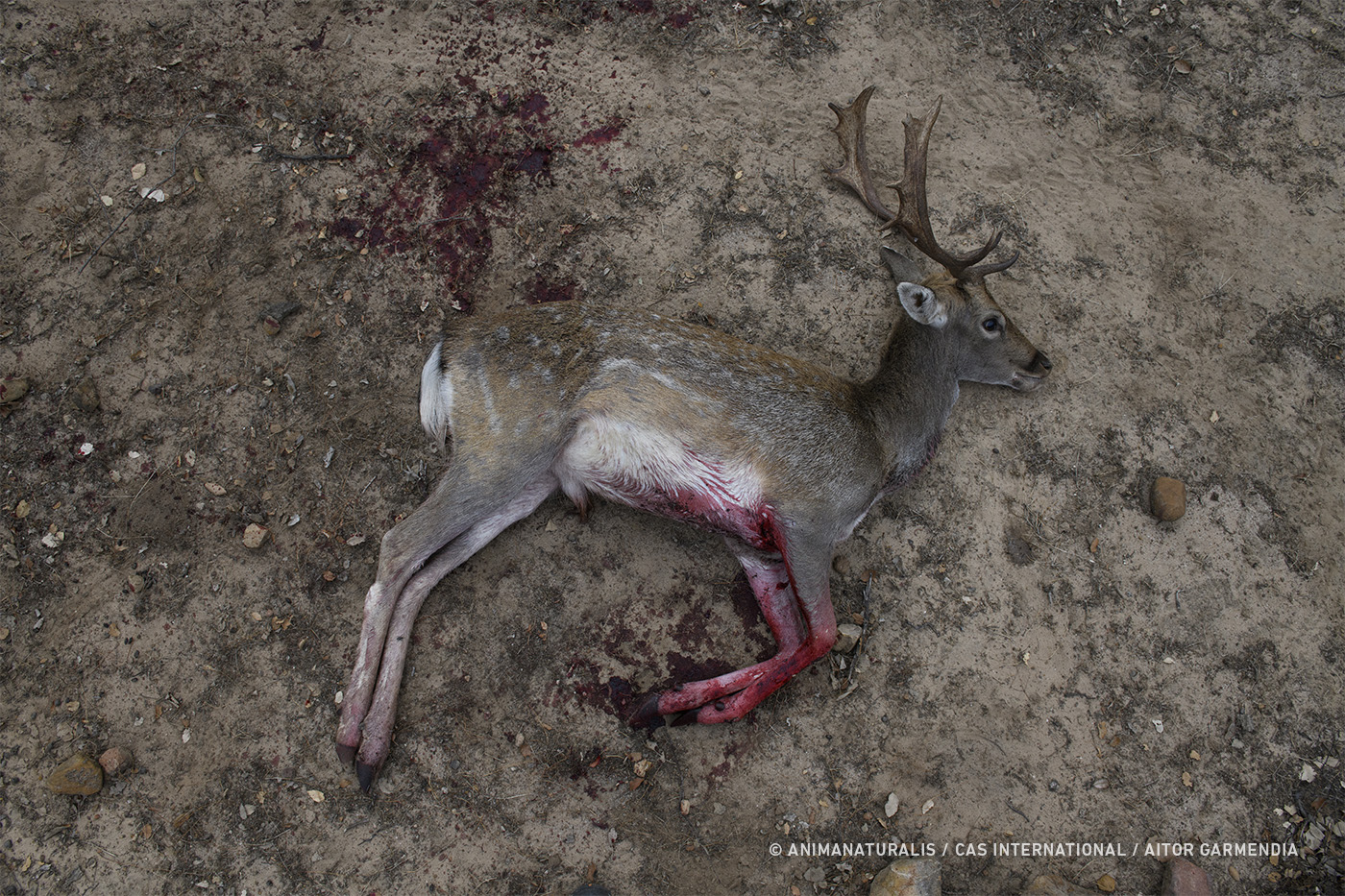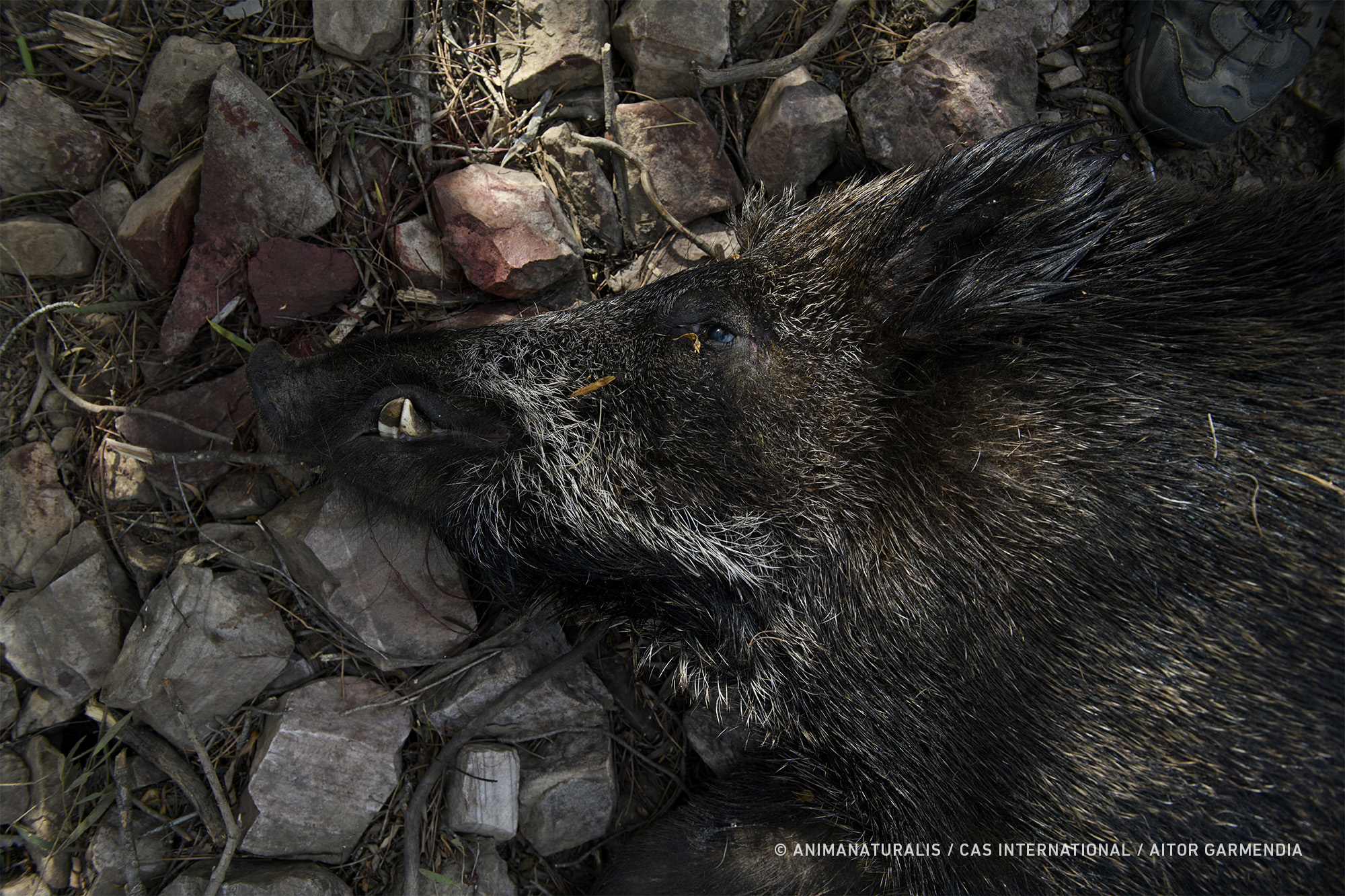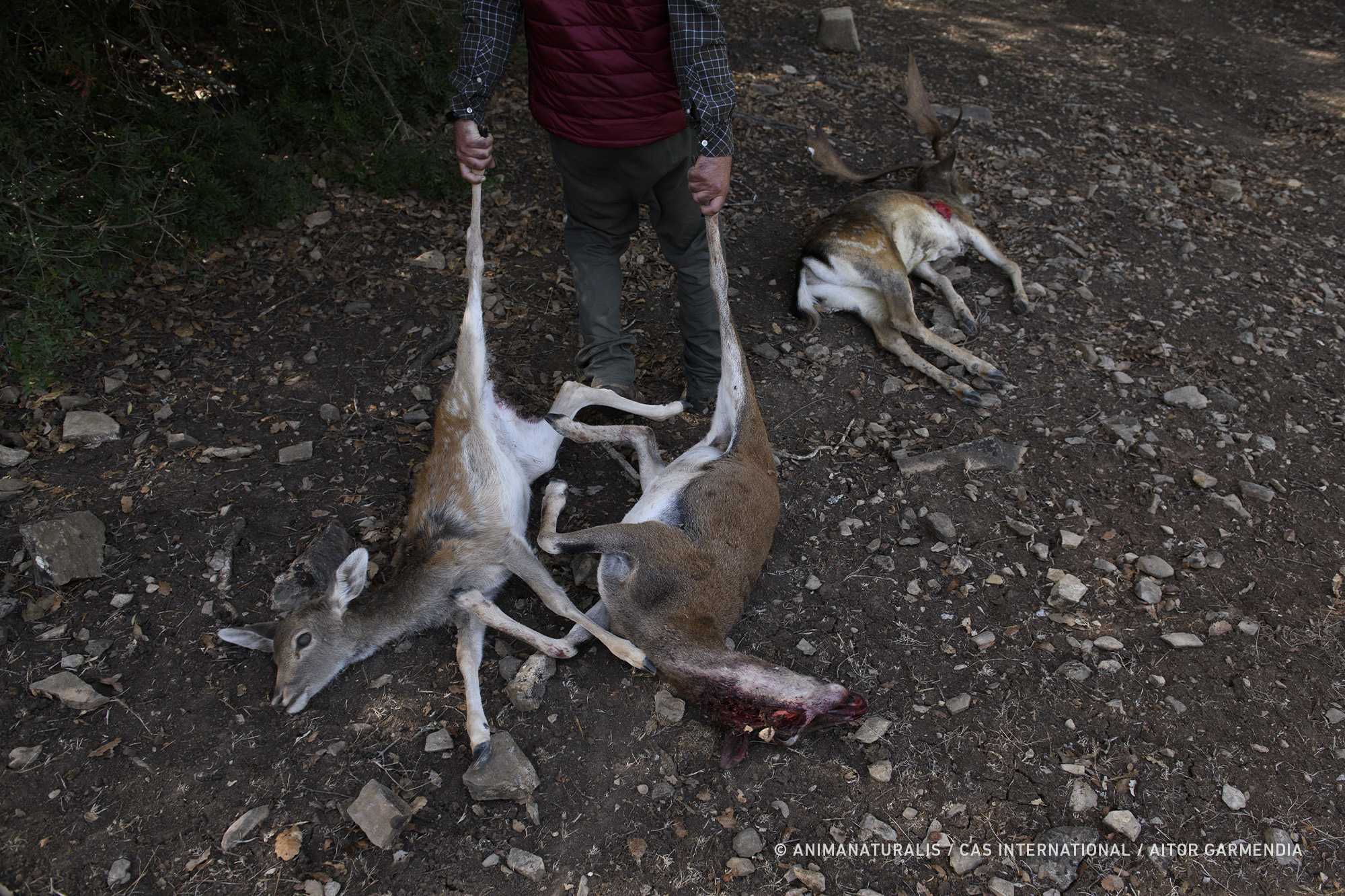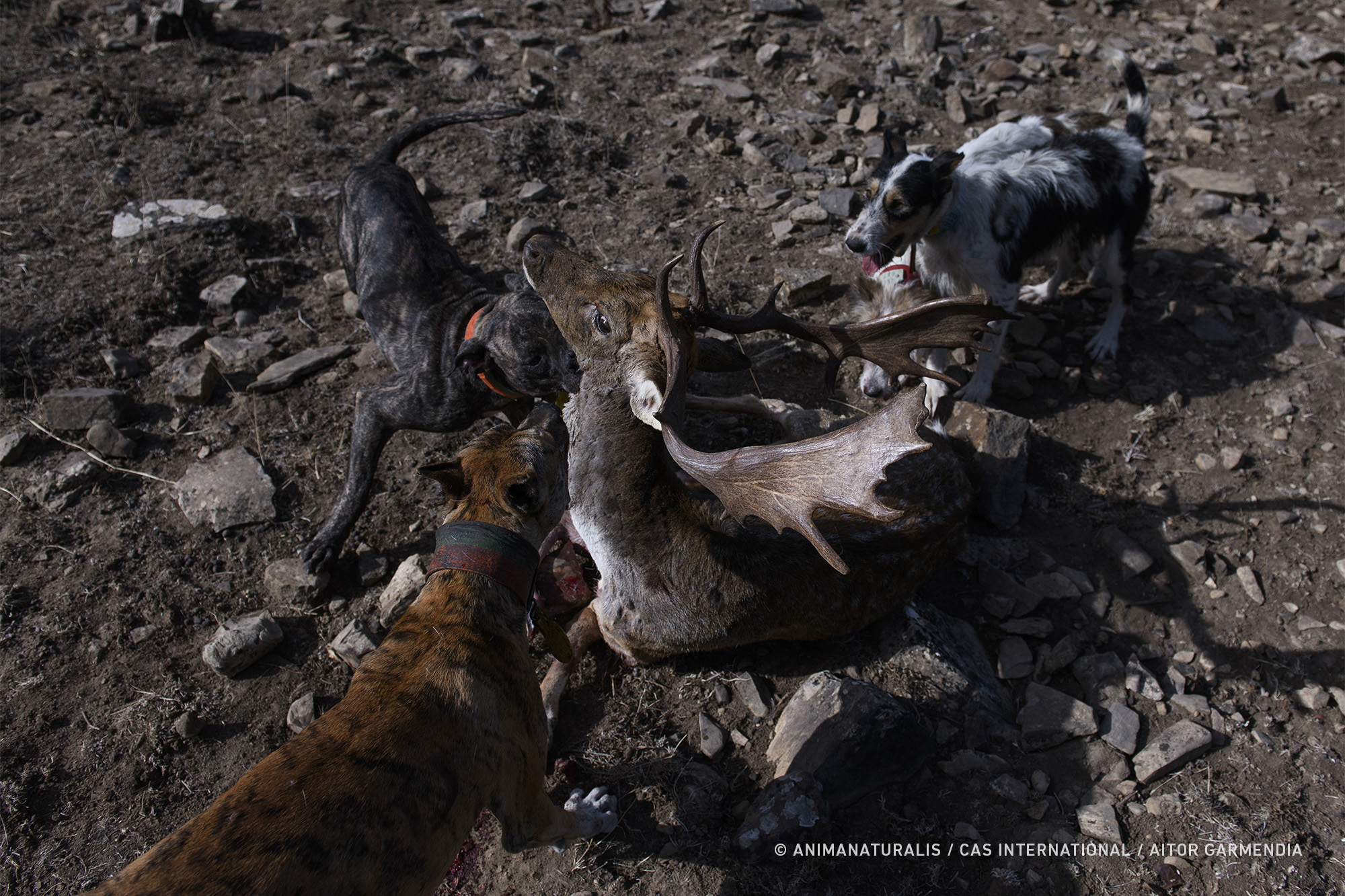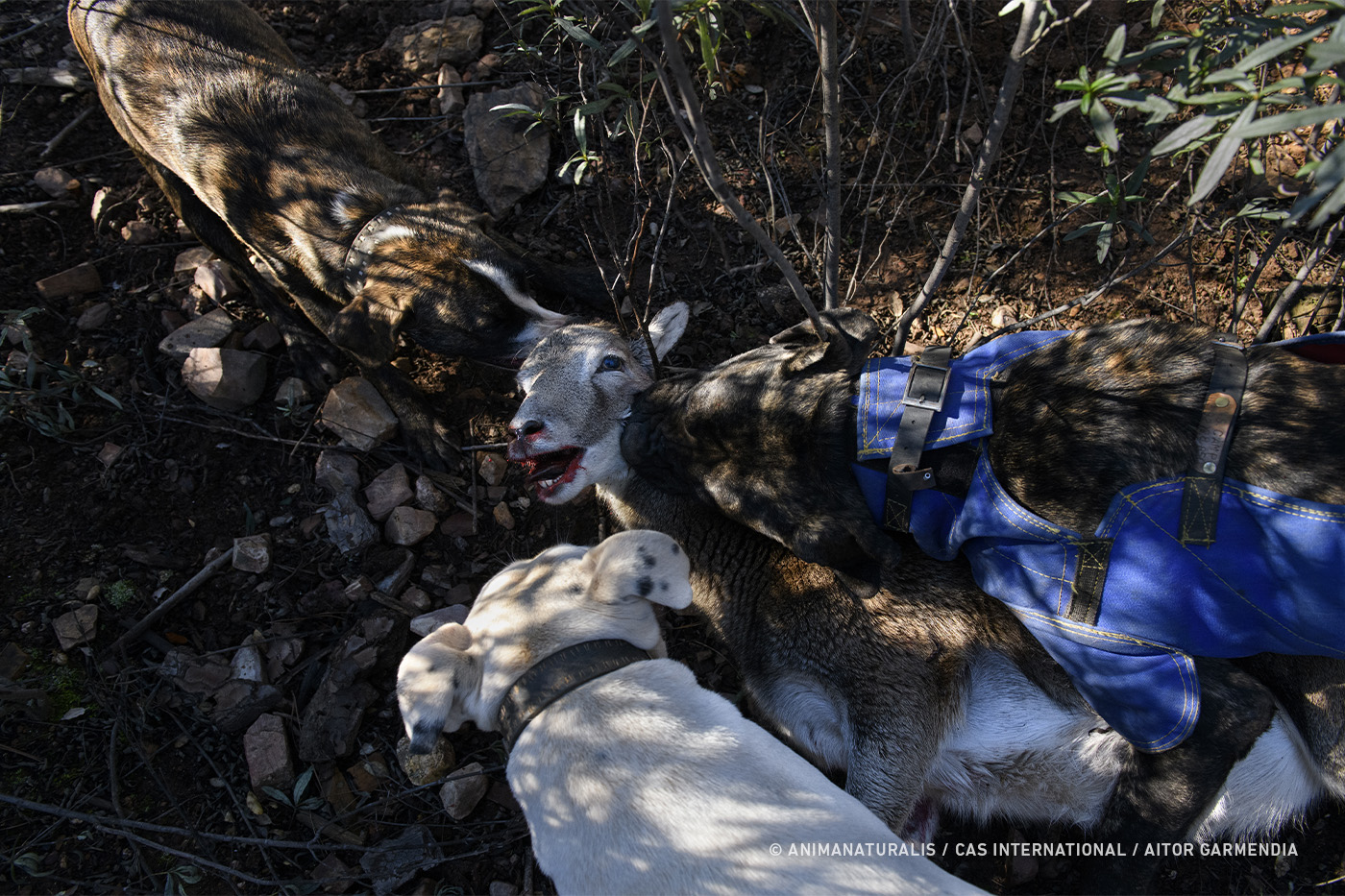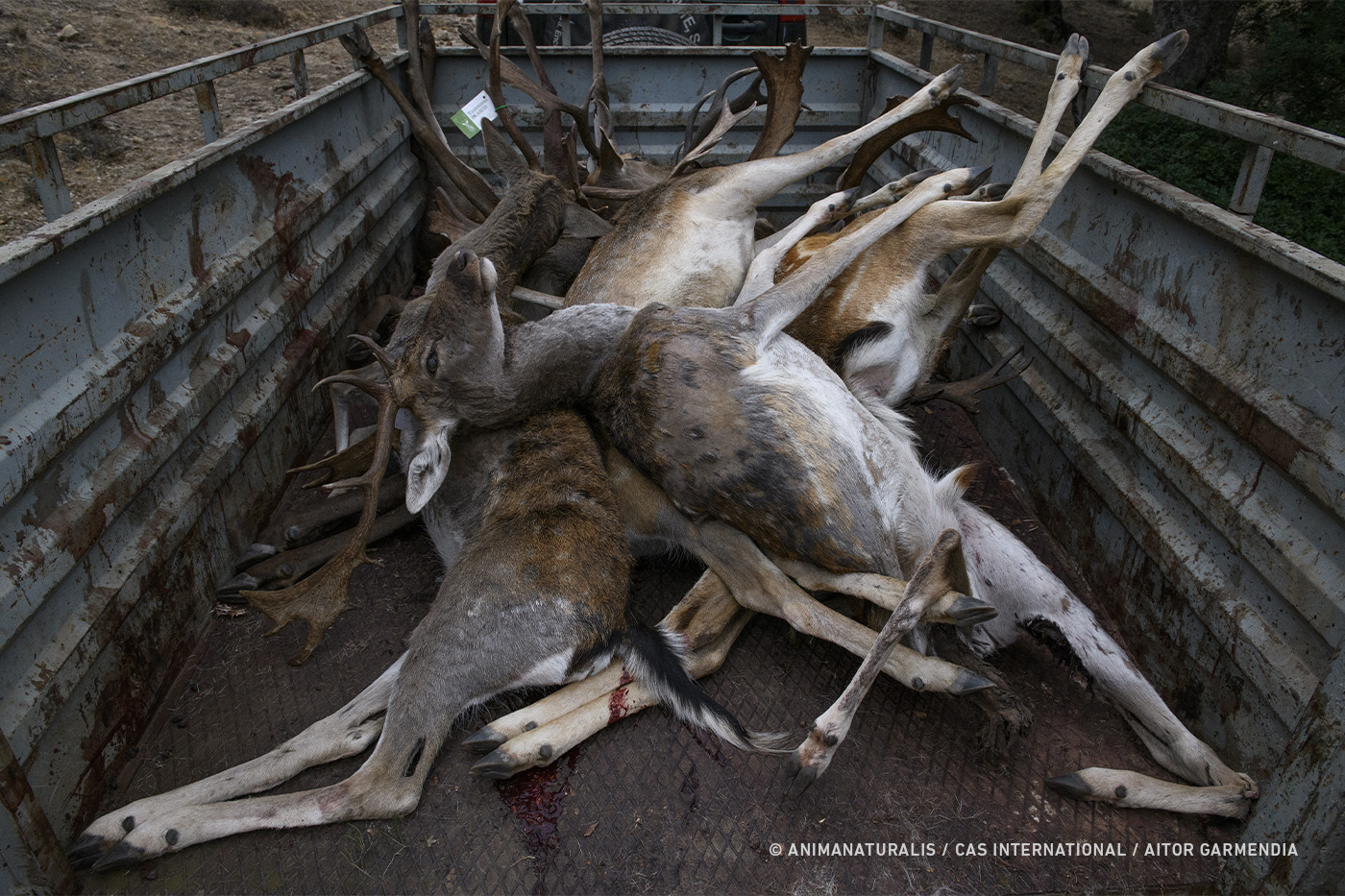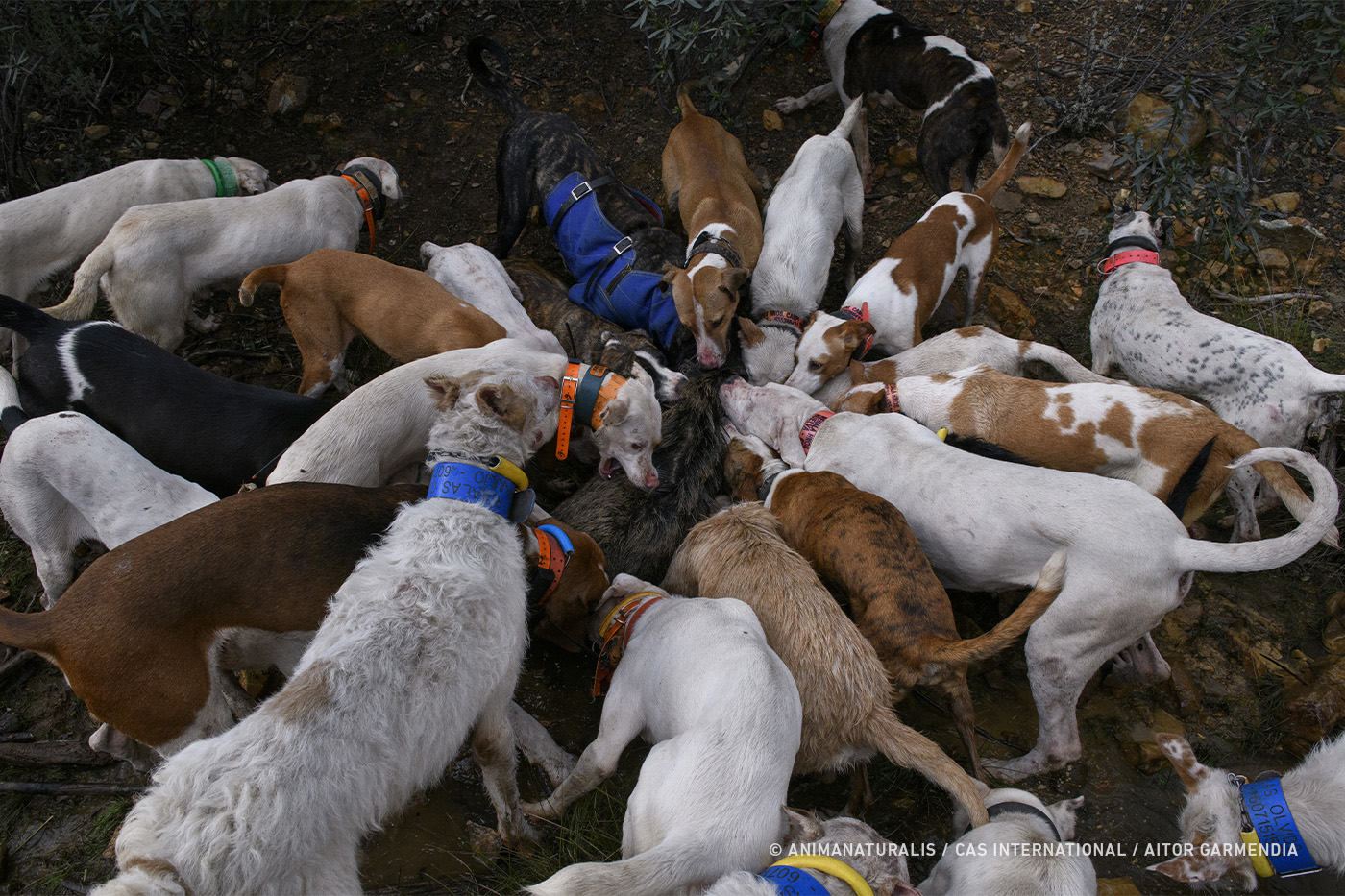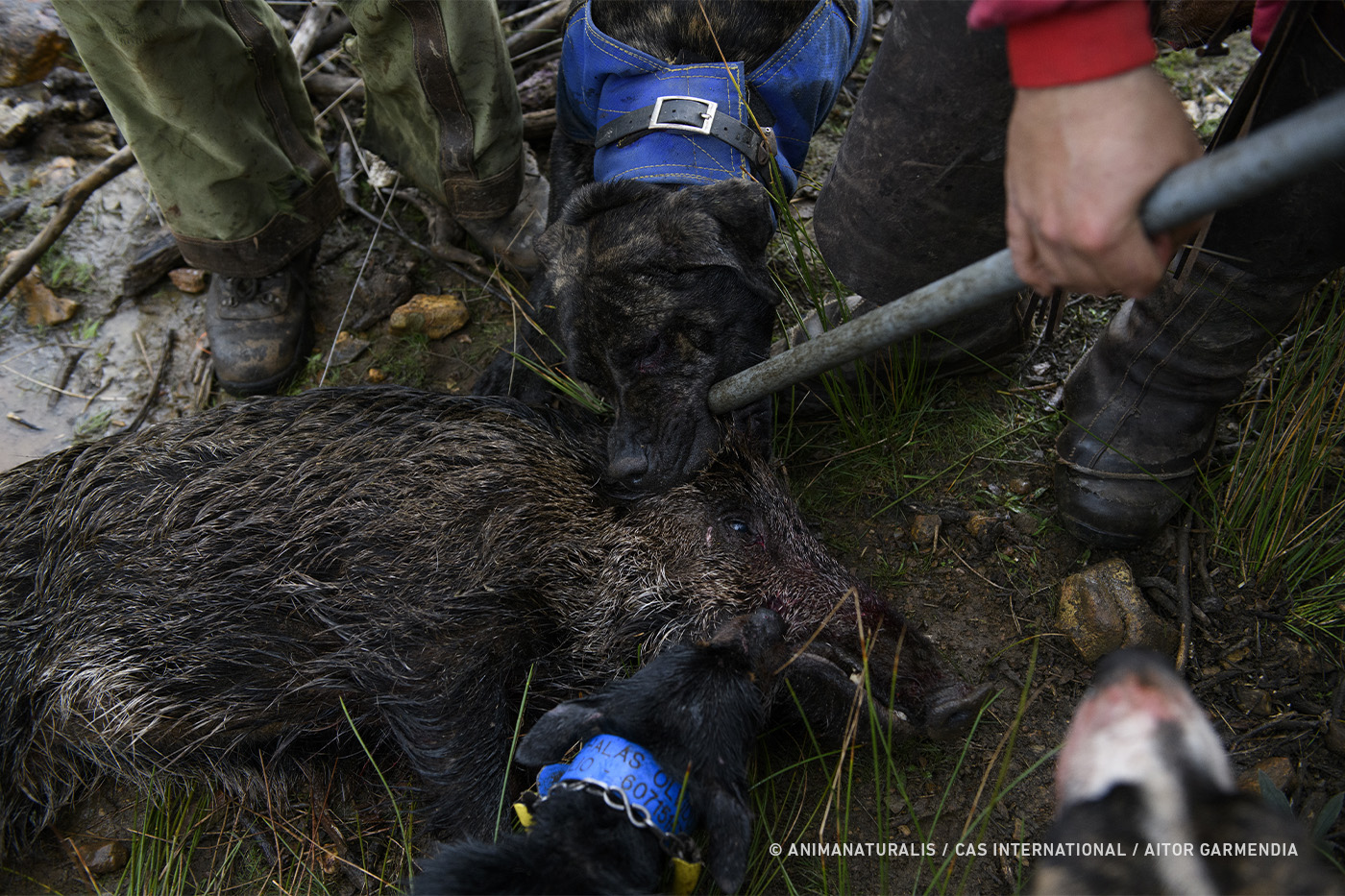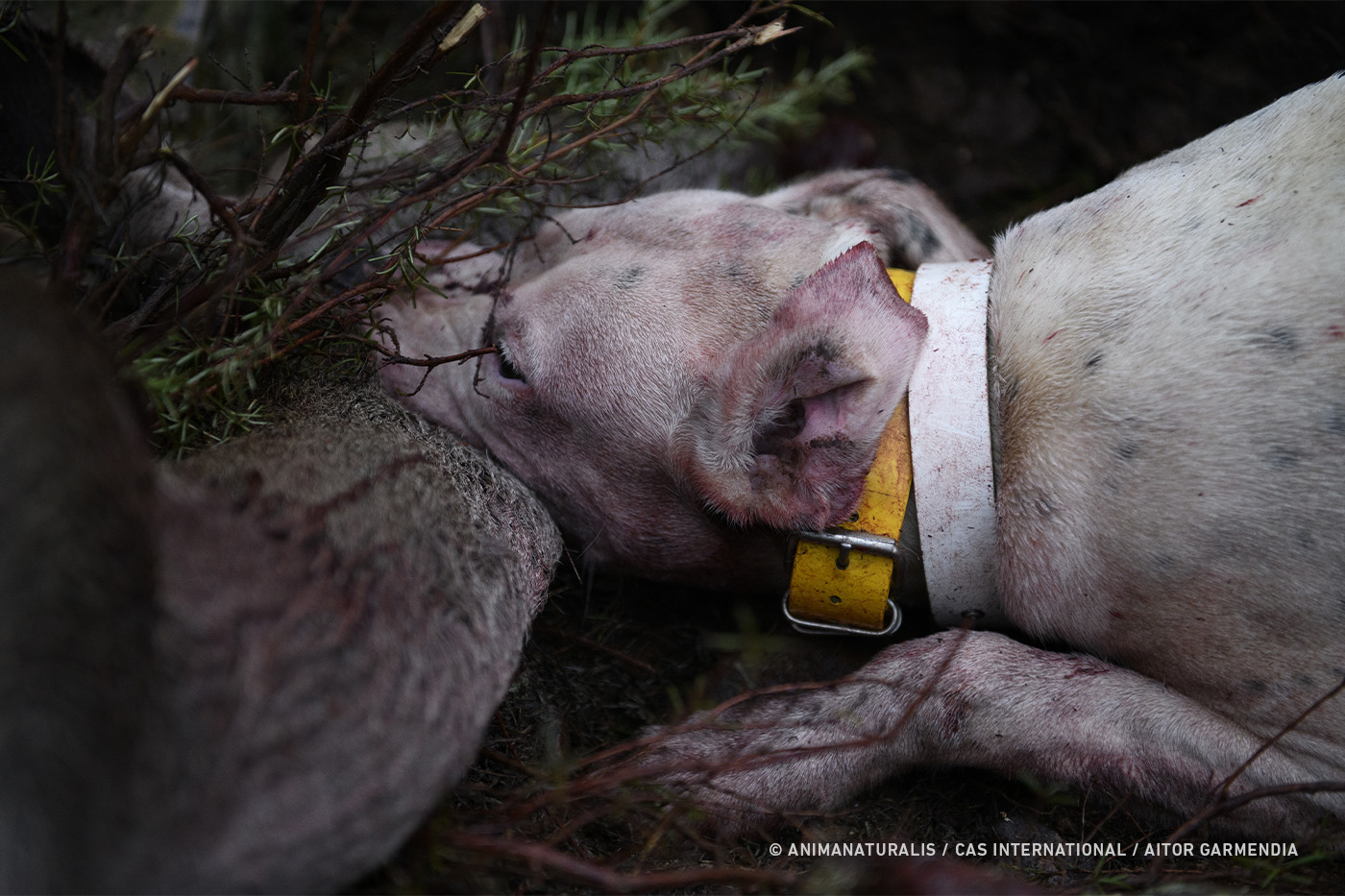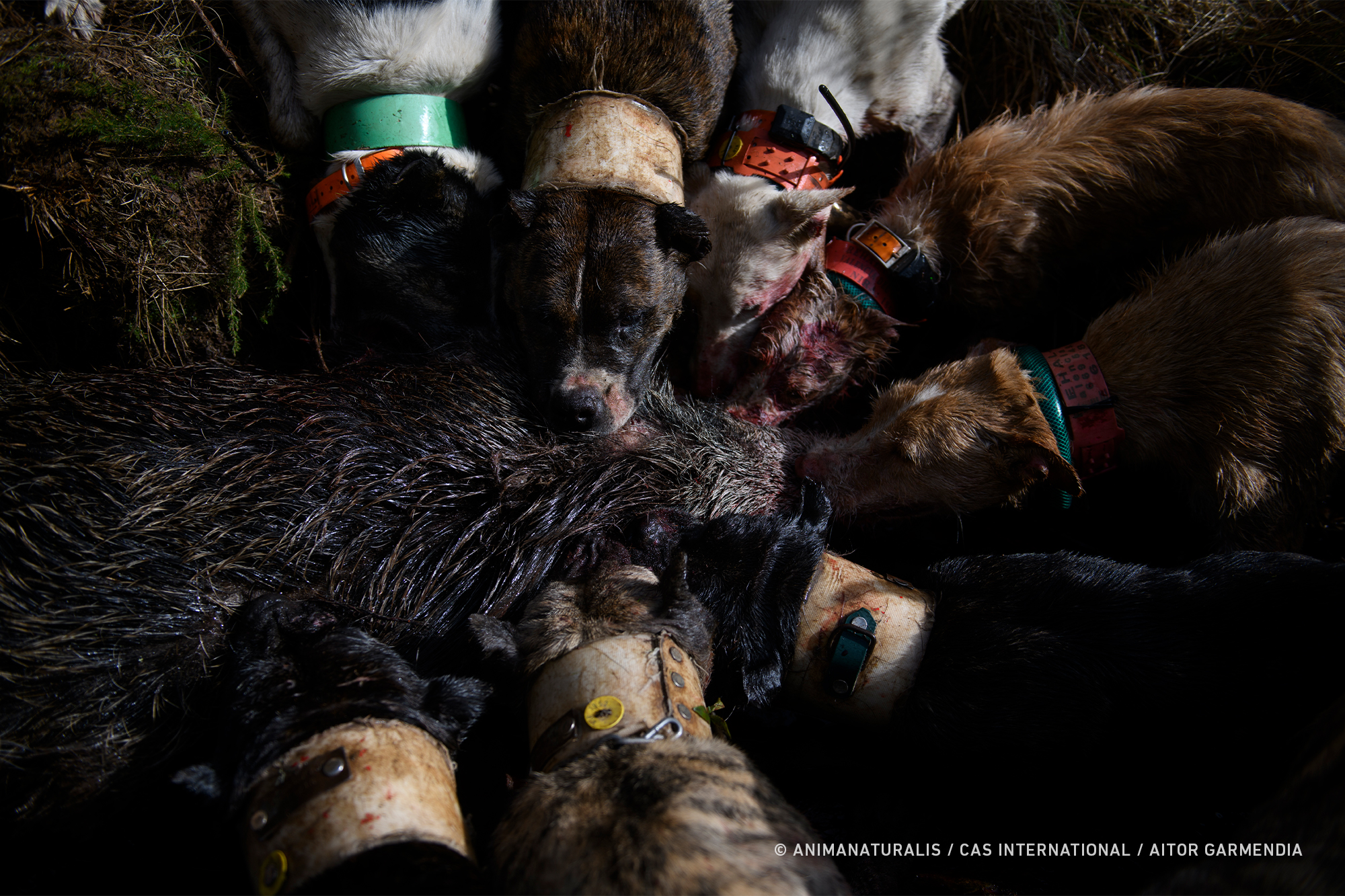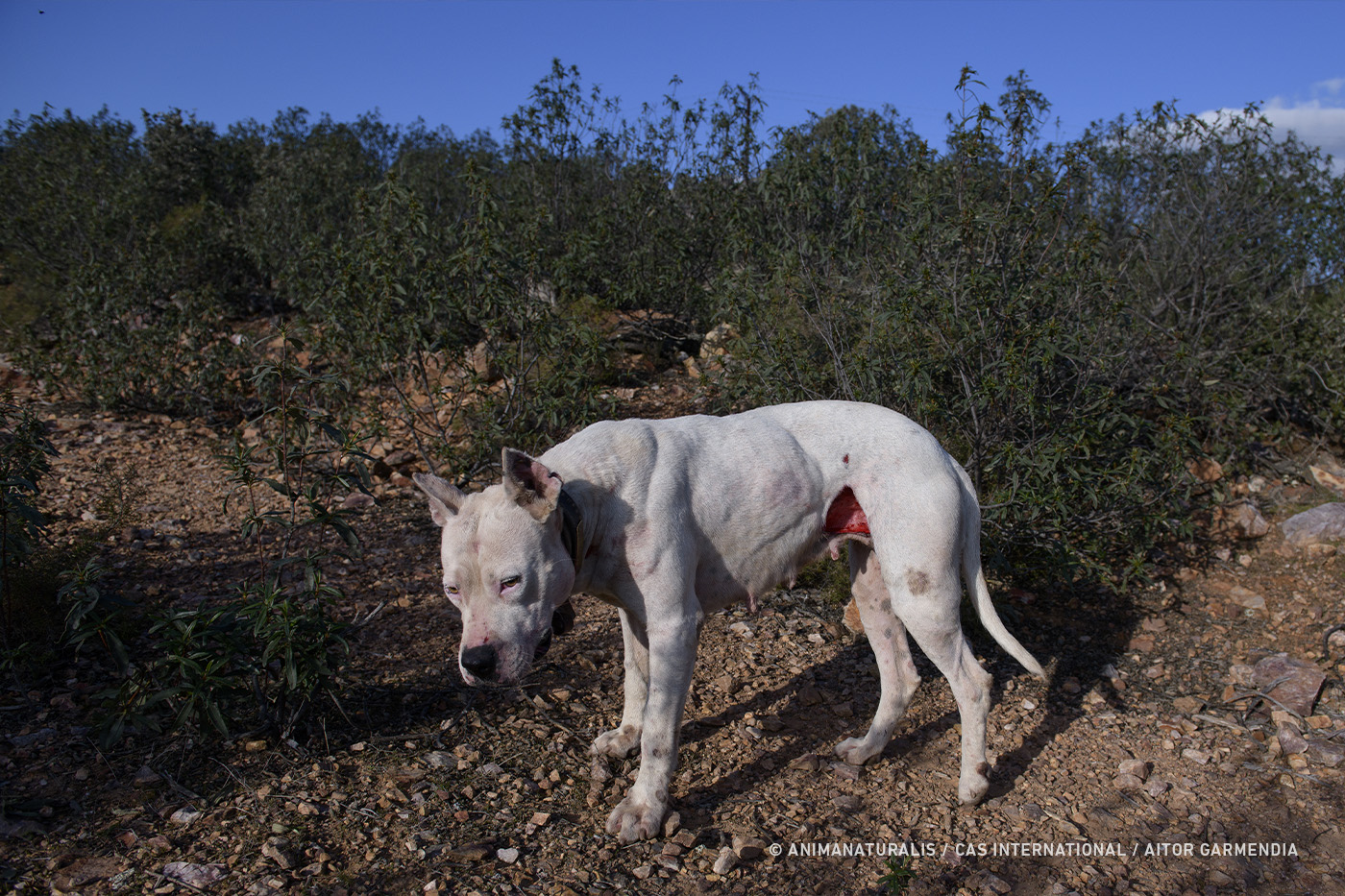AnimaNaturalis and CAS Internacional uncovered the cruelty of hunting with dogs in Spain, precisely when the PSOE has announced that it is not a priority to draw up specific legislation for dogs used in hunting as regional regulations already exist. It had promised in September to publish this regulation to justify its exclusion from the recently passed animal welfare law.
The images of the investigation come from 11 hunts in various provinces of Spain, 1 hatchery, 2 kennels for rehals and a game meat processor, all documented between 2021 and 2023. The images show badly injured dogs, stabbings, game animals dying , hunters suturing the wounds of their dogs without veterinary supervision, and even the use of illegal drugs.
It is the most characteristic modality of the Iberian Peninsula. In it, rehalas of up to 40 dogs are used to track, harass and direct deer, wild boar and other animals to the posts where the hunters wait with their rifles. In big game alone, 582,290 animals were killed in 2020. Normally the hunts are held in closed preserves, sometimes with barbed wire on the fences, where the prey has no escape.
Precisely because of the brutality that it entails and the possibility of suffering injuries and confrontations with other animals, the use of dogs in hunts in the open field is prohibited in most EU states. Apart from Spain, dogs can only be used directly against game in Portugal and France.
"In the hunts, dogs are forced to become weapons and are no longer seen as beings who feel and have needs. This lack of empathy places us at the bottom of Europe in terms of animal welfare", says Aïda Gascón, director of AnimaNaturalis in Spain.
We have consulted numerous official sources to confirm that there is no official registry of dogs used in hunting, so the data on their breeding and abandonment -two of the main problems that concern them- are the result of estimates obtained in collaboration with protectors. Affinity Foundation points to hunting as the second cause of abandonment in the country, and estimates about 22,000 dogs discarded in 2021 by hunters, 13% of the total.
The recent exclusion of these dogs from the Animal Protection Law means that they could also be ignored in the future state registry of companion animals, so the lack of control in breeding and their protection will continue to be a problem ignored by the administrations in Spain.
Breeding
During the investigation, a hatchery was visited in which the materials of the spaces were consumed by rust, had holes in the metal plates, iron and sharp edges in their spaces. We observed bad water in the drinkers, pieces of stale bread directly on the droppings, and careless handling of the pups.
In order for the dogs to fulfill their function within the rehala, specific characteristics are sought in them that are usually obtained by breeding certain breeds and outstanding individuals. This selective crossing favors the development of congenital diseases, being able to considerably reduce the life expectancy of the animals. Indiscriminate breeding also increases the cases of abandonment of unwanted litters.
Within the rehala, dogs can fulfill different functions that primarily pursue three purposes: finding the victims, forcing them to move towards the posts and being able to confront them and immobilize them. Some of the most used breeds are hounds, the griffon or the bloodhound for their sense of smell and speed; the Spanish alano, the Argentine bulldog, the mastiff and others, for their strength, along with a variety of crosses.
Legally, there is no minimum age at which puppies can start hunting, so both this and the moment of their withdrawal depend on the criteria of their owner.
Kennels
In previous research presented in 2022, AnimaNaturalis and CAS showed 29 hunting kennels where dogs live in unsanitary conditions, exposed to inclement weather, often without access to clean food or water, and in very small spaces.
In the case of rehalas, their owners can house more than fifty animals in kennels, either separated from each other by cages, or in large warehouses. They remain chained to the floor or wall at all times.
Zoos are regulated by regional animal protection laws, so there are no homogeneous characteristics that must be met. Depending on the rebreather and the property, the dogs may have a patio where they wait while cleaning and maintenance of the space is carried out.
We cannot know the time they spend without being tied up beyond the development of their activity during the season, since neither the Hunting Regulations nor the regional laws specify a limit in which they can be tied up.
Several rehaulers refused to show their kennels during the hunting season, claiming that in those months they do not have time to clean them. This allows us to assume that in the images obtained the spaces were neater than usual.
Transport
Dogs can travel long distances on the road when rehaleros move between provinces or communities. If they go to more than one hunt in a row, the dogs spend the night in trailers and vans.
The community regulation establishes that the owner of pets may be accompanied by a maximum of 5 animals except in certain exceptions, among which participation in a sporting activity is included, which is precisely the legal consideration that this type of hunting has. On this new assumption, a limit number of dogs that can be transported is not specified.
When the trailers open, the dogs jump out hastily, stepping on each other and overexcited. In each one, more than thirty animals can go, sometimes with the chains surrounding their necks directly without a collar, which could cause misfortune in the event of a collision or accident.
In this area, the state regulations only specify that the vehicles must be correctly registered, and that it must be possible to prove the disinfection of the trailer in the 48 hours following the loading of the dogs. It does not establish rest times for journeys, the obligation to have enough water or food, or any type of measure in relation to ventilation.
Injuries
Although for all dogs participating in hunting carries a risk, those considered "grabbing" are the most exposed to danger, since they are responsible for immobilizing the animals they are chasing.
When a wild boar hurts a dog, it is said among hunters that it has "pricked" it. We have been able to see some dogs wearing protective vests completely pierced by the tusks of wild boars. Some had very deep wounds. In general, most of the dogs in the rehalas were not wearing vests or protected in any way.
It is the rehaleros themselves who suture the wounds of their dogs or close them with a stapler during the hunt. They also administer injections and medications, but at no time are these procedures given under veterinary supervision. During the investigation, on one occasion we were not allowed to record a healing with our cameras. The rehaler claimed he was feeding the dog an illegal drug and preferred not to have a record of it.
When a dog is injured, the rehaleros tie them to the trees so that they will not follow them, so they can continue the hunt while the dogs recover or do not worsen the injury. Sometimes the dogs manage to get loose to continue accompanying the hunters through the bush. On one occasion, several dogs found another tied up, alone and vulnerable, and they all attacked him.
“We have seen animals that, due to their injuries, have been unable to hunt. Others with deep cuts in the neck, the flank pierced or the diaphragm out. We also have evidence that at least three dogs died of dehydration in one of the hunts, according to what the rehaleros themselves announced", laments Gascón.
Hunting dogs in Spain
This is the reality of hunting dogs. Already in 2021, the European Parliament transferred to the Spanish Government and the 17 autonomies its concern about the precarious situation and lack of protection of these animals. However, far from listening to these recommendations, both the montería and the rehala are considered an Asset of Cultural Interest (BIC) in Andalusia and Extremadura since 2020 and 2022, respectively.
In most of the Autonomous Communities, dogs used for hunting are considered as pets, except in exceptions such as Andalusia, where they fall into the category of production animals and are considered "hunting uses".
We denounce that, in fact, no regional law avoids exposing dogs used for hunting to situations that could pose a danger to their physical integrity or cause their death. We also denounce that the laws are too lax and that they do not prevent them from spending most of the time chained or locked in open-air cages under extreme weather conditions.
At the national level, the rehalas and sports kennels have Hunting Law 1/1970, which stipulates that it is necessary for the owners of the rehalas to be in possession of a special license. It is the type C license. The same one that authorizes hunting with falconry birds and ferrets. Despite this, no State body has segregated data on hunters who use dogs.
"It is unheard of that Spain is once again the exception in Europe in the most harmful practices with animals. It is urgent to put an end to modalities such as hunting and other extremely brutal and dangerous forms of hunting," explains Gascón. "Honestly, we believe that hunting is a cruel and unnecessary activity, and we should move as a society towards its total elimination. The first step is to put an end to its most inhuman expressions, such as hunting", she adds.
The hunting lobby has influenced legislation that avoids regulating, controlling and limiting its activity at all costs. This evidence makes it imperative that the authorities take responsibility for improving the laws for the protection of dogs used in hunting. Whether at the state level or in each Autonomous Community, "any reform should have the advice of animal protection organizations and be based on scientific arguments and not just commercial reasoning or mere tradition", explains Gascón.
On the other hand, hunting licenses presented their lowest figure in the last two decades in 2020, a downward trend that has not rebounded since 2010. It should be noted that 85% of the Spanish territory is used for hunting -in La Rioja it reaches 99 %-.
The objective of our investigation is to denounce the mistreatment and sustained and normalized suffering of animals in hunting. The specific situations that have been registered are not exceptions or negligence, but the standard of this practice. "It is not our intention to denounce hunters or even criminalize the people who appear in the investigation. Our concern is the animals and these images seek to get the authorities to address the urgent problem of their protection", adds Gascón.
Both animal welfare and animal rights are issues of public interest, which is why we consider that this work should serve to keep the debate alive and continue advancing in its defense.
With this investigation, AnimaNaturalis and CAS International launch our new #StopHunting campaign, and we ask the population to sign the petition to request greater protection for dogs used for hunting, urgently eliminating the most dangerous and unnecessary modalities.
We need your support
AnimaNaturalis exists because billions of animals suffer at human hands. Because they animals need solutions. Because they deserve someone to speak up for them. Because animals need change. Because at AnimaNaturalis we want to build a fairer world for everyone.
The donations of our supporters are the main source of our funds.

